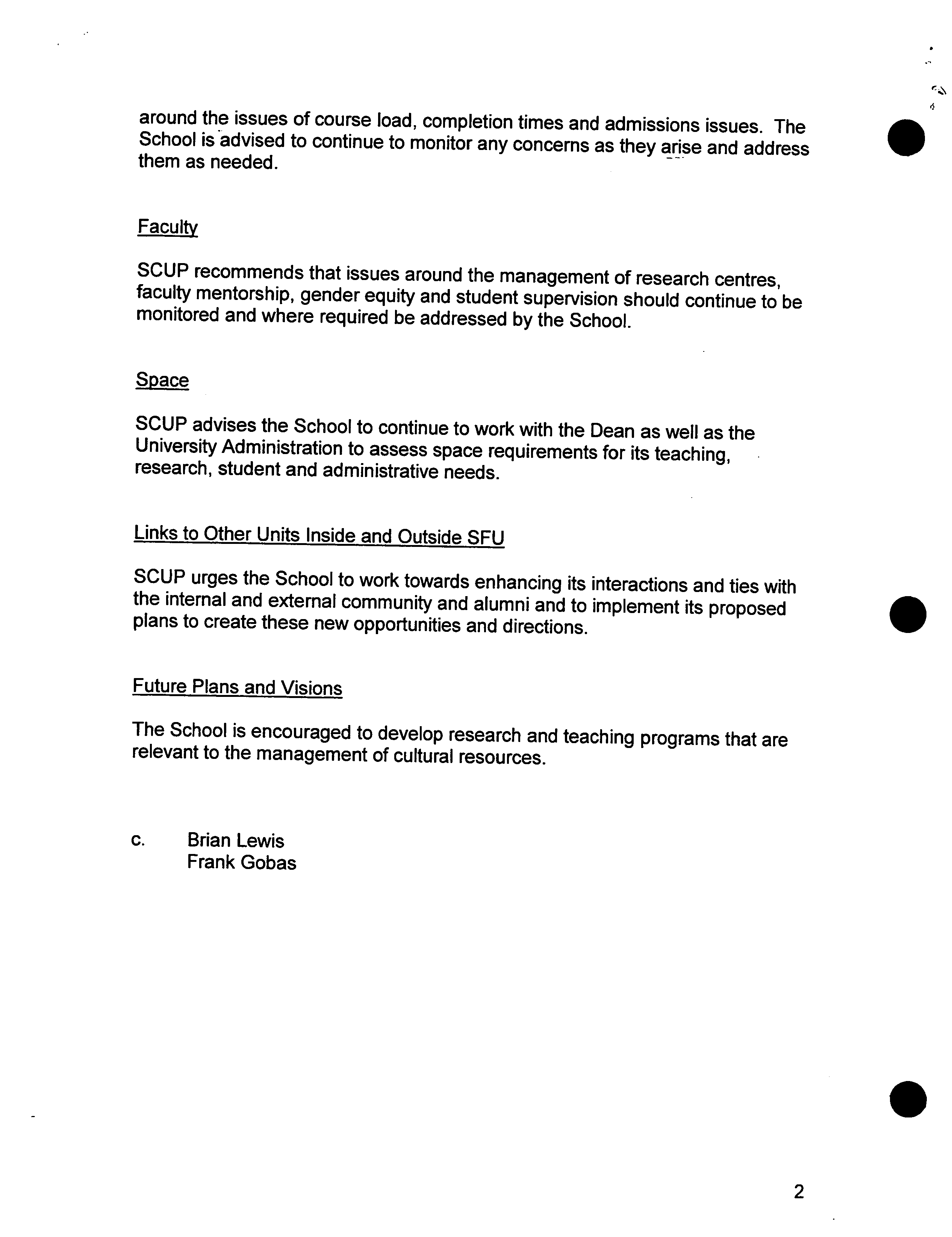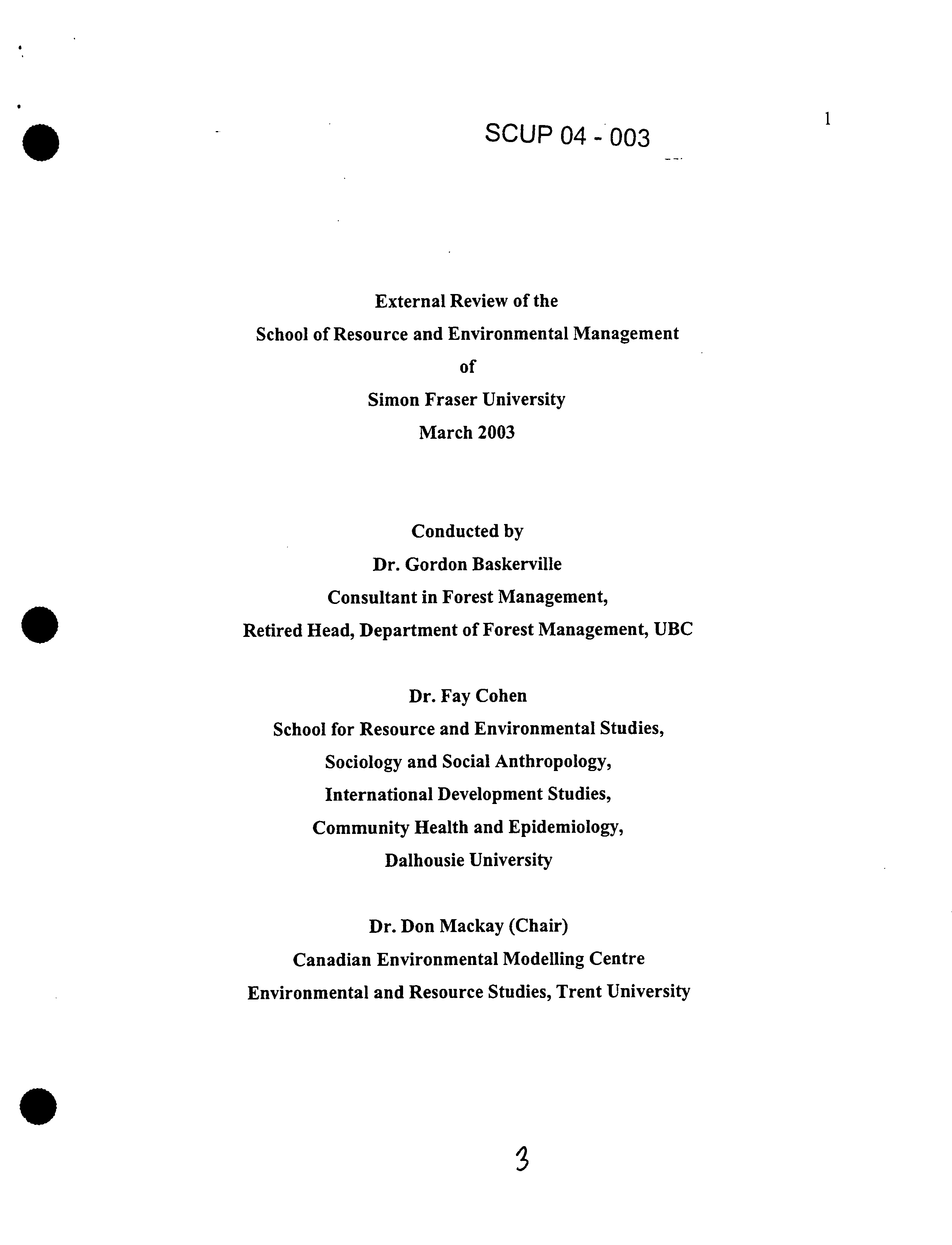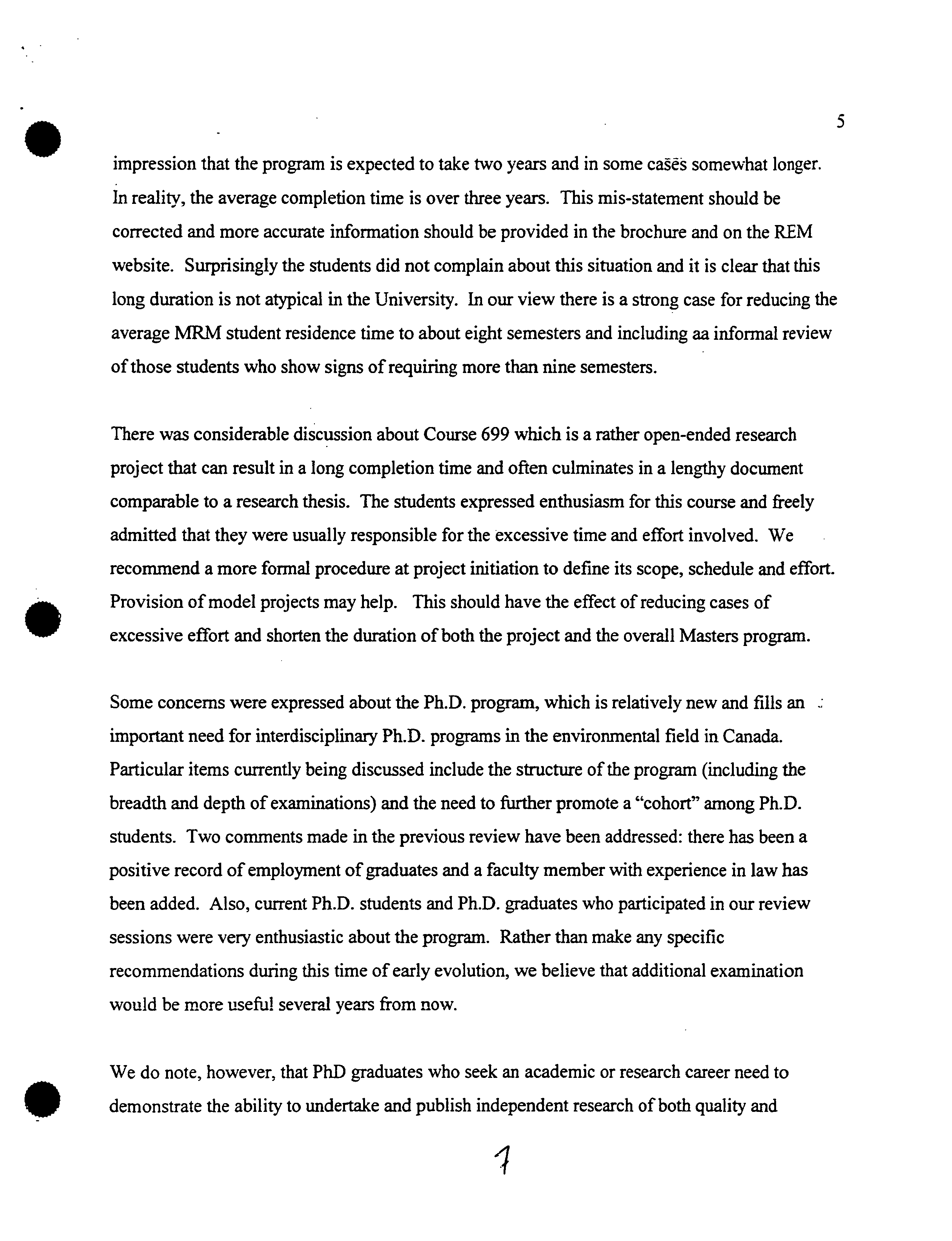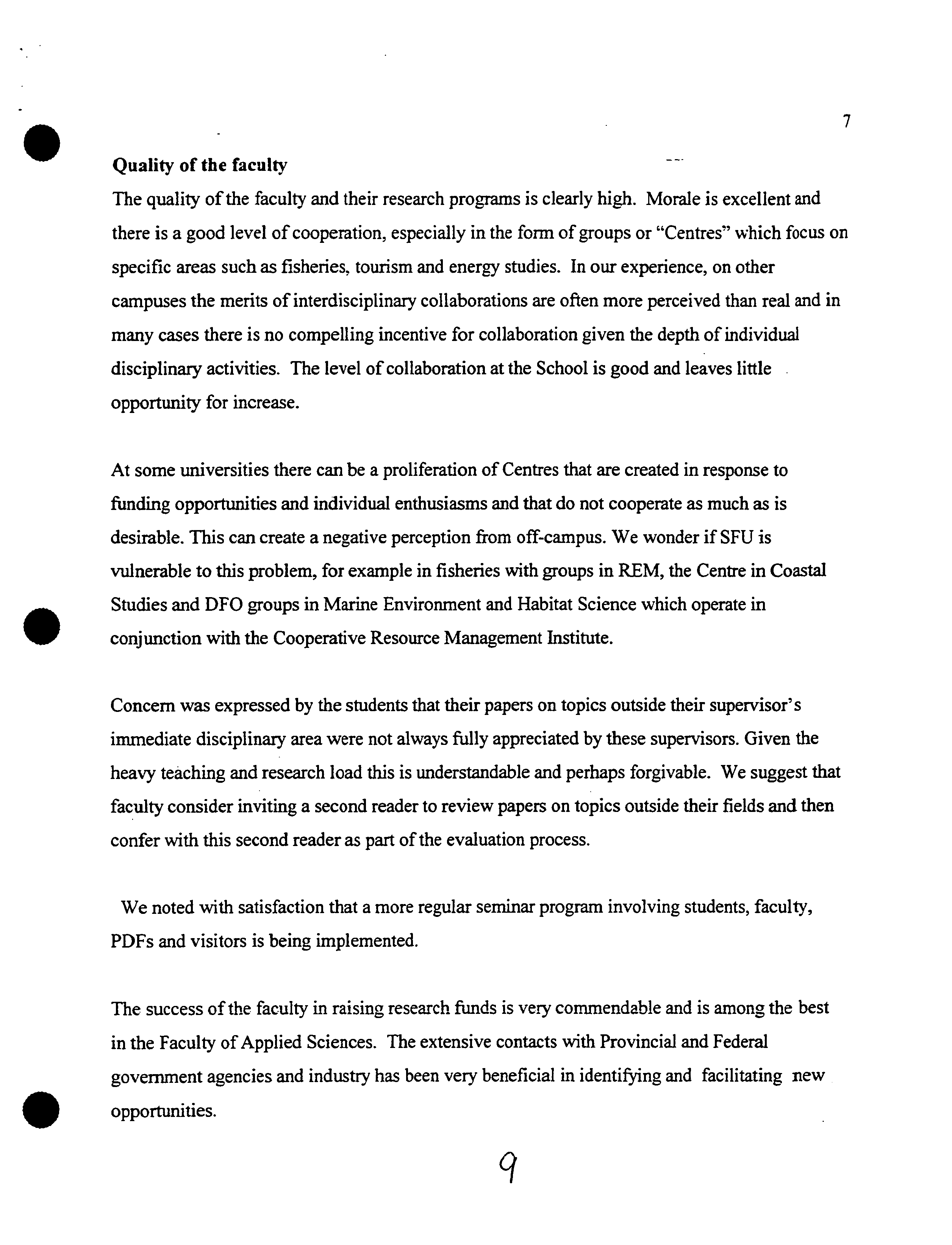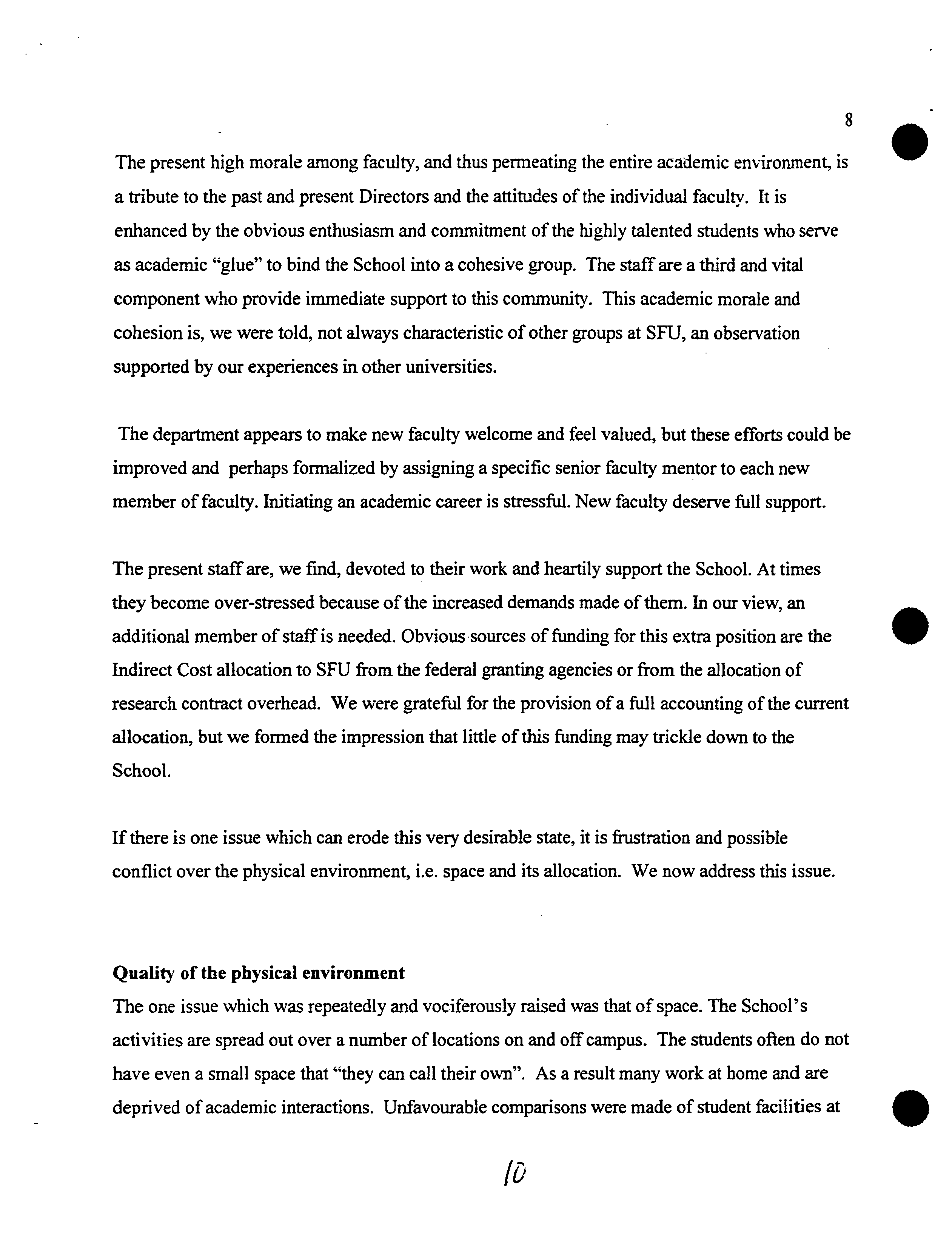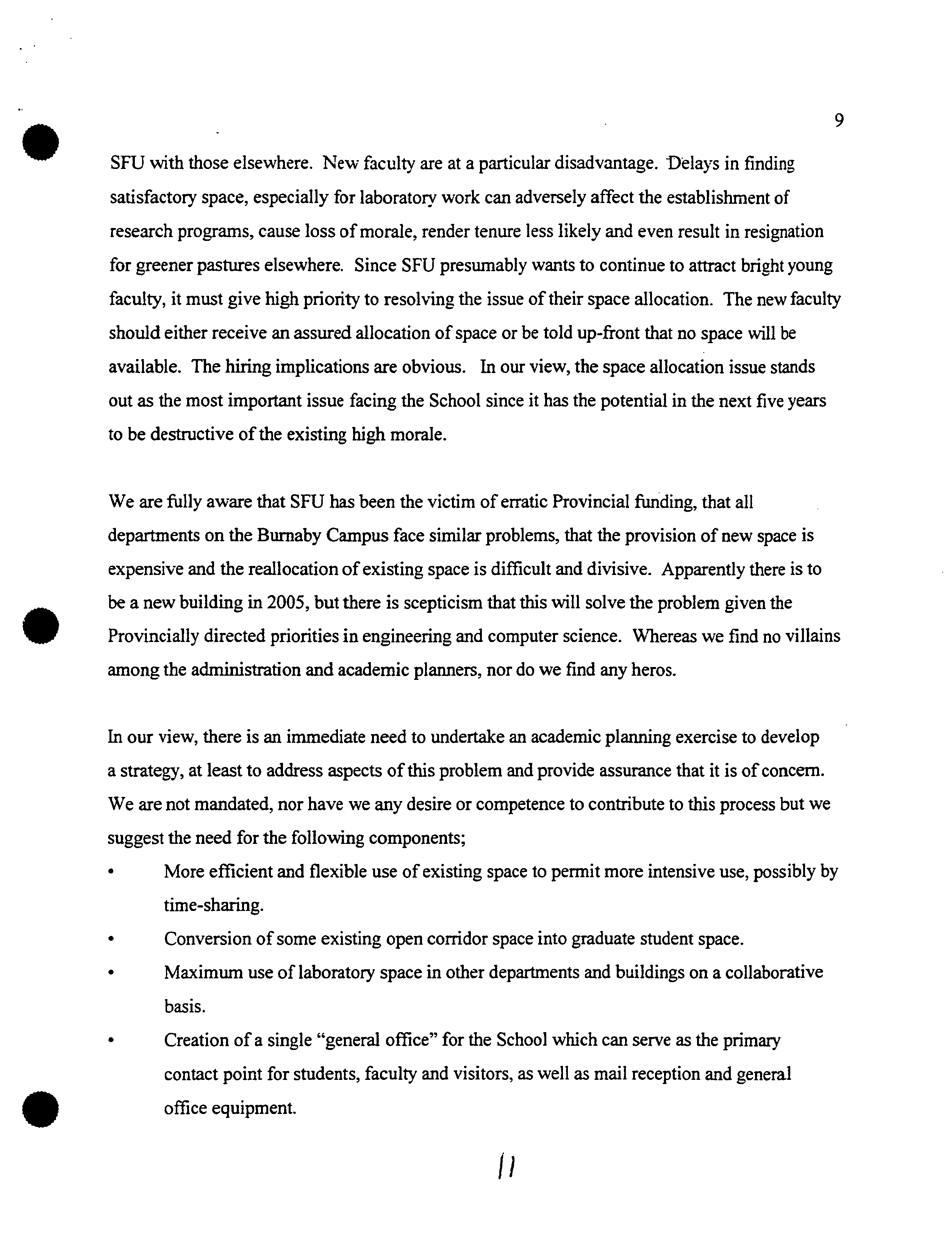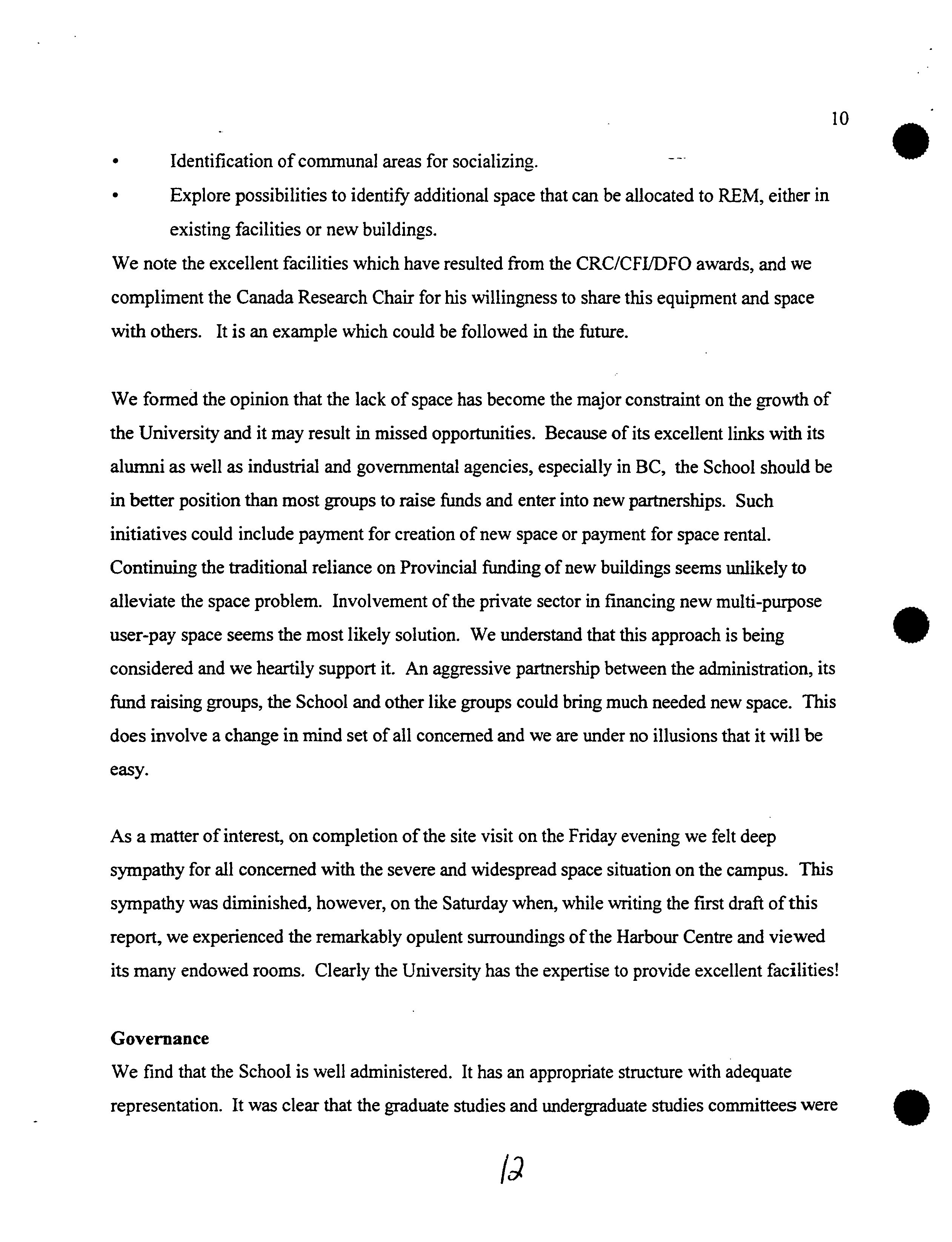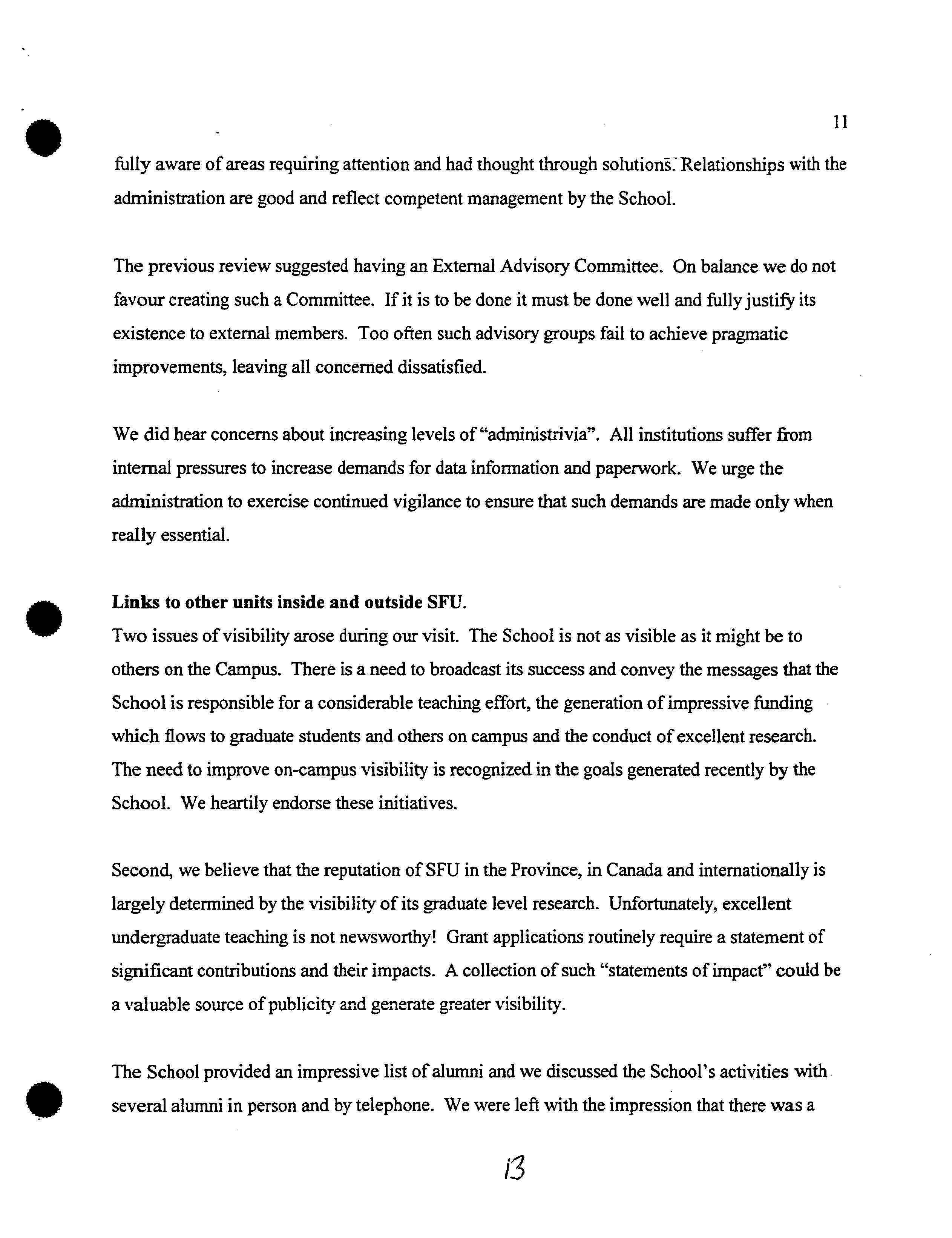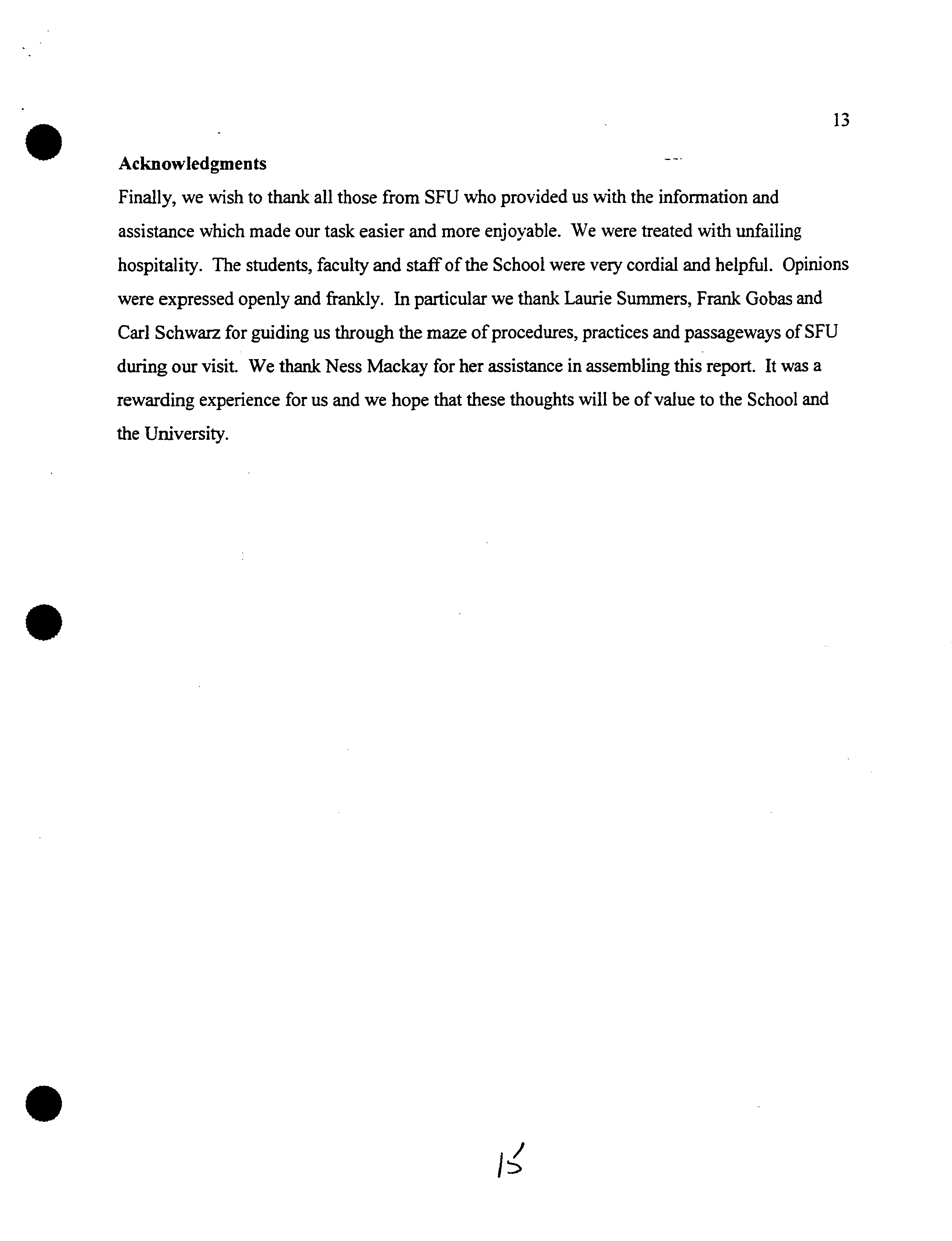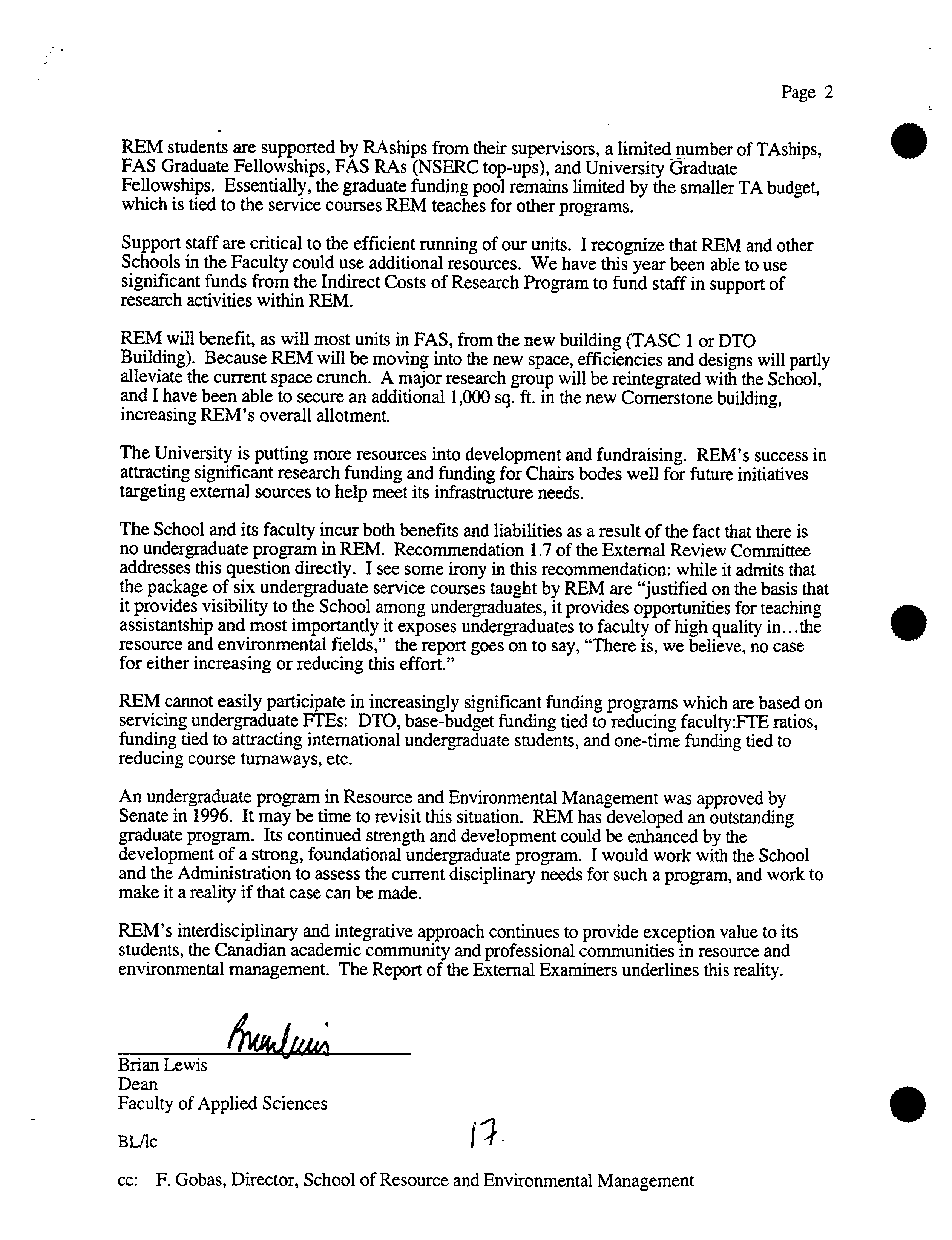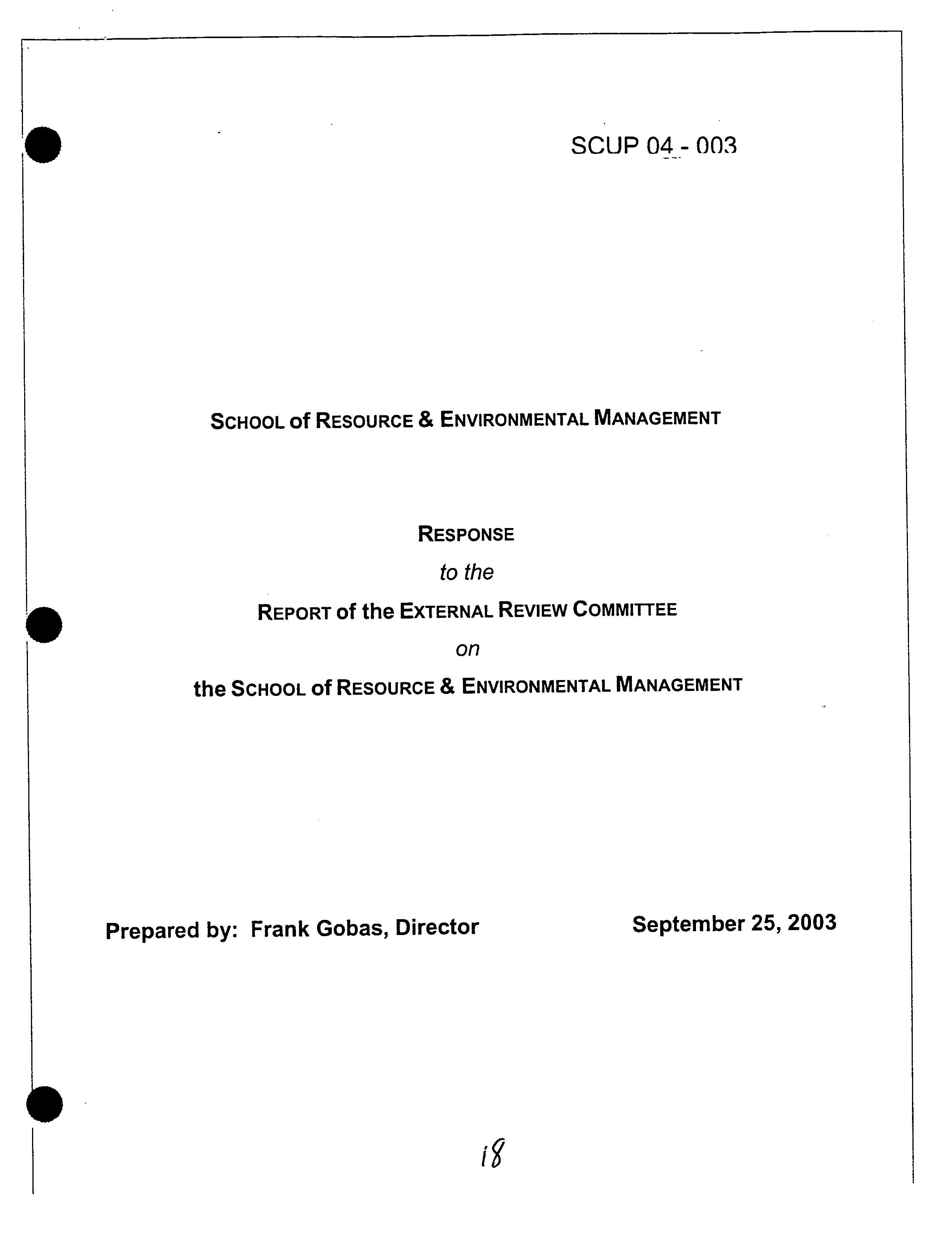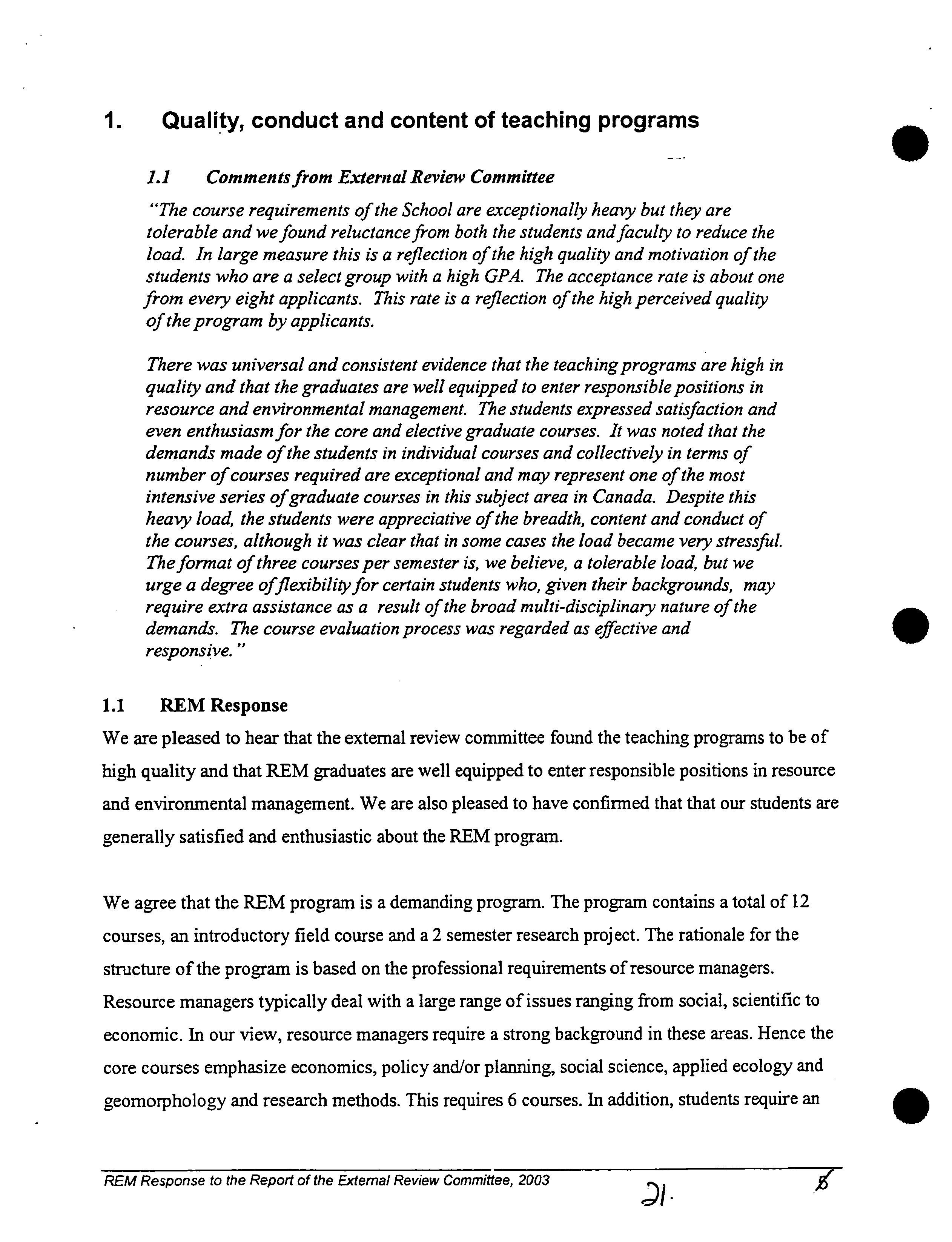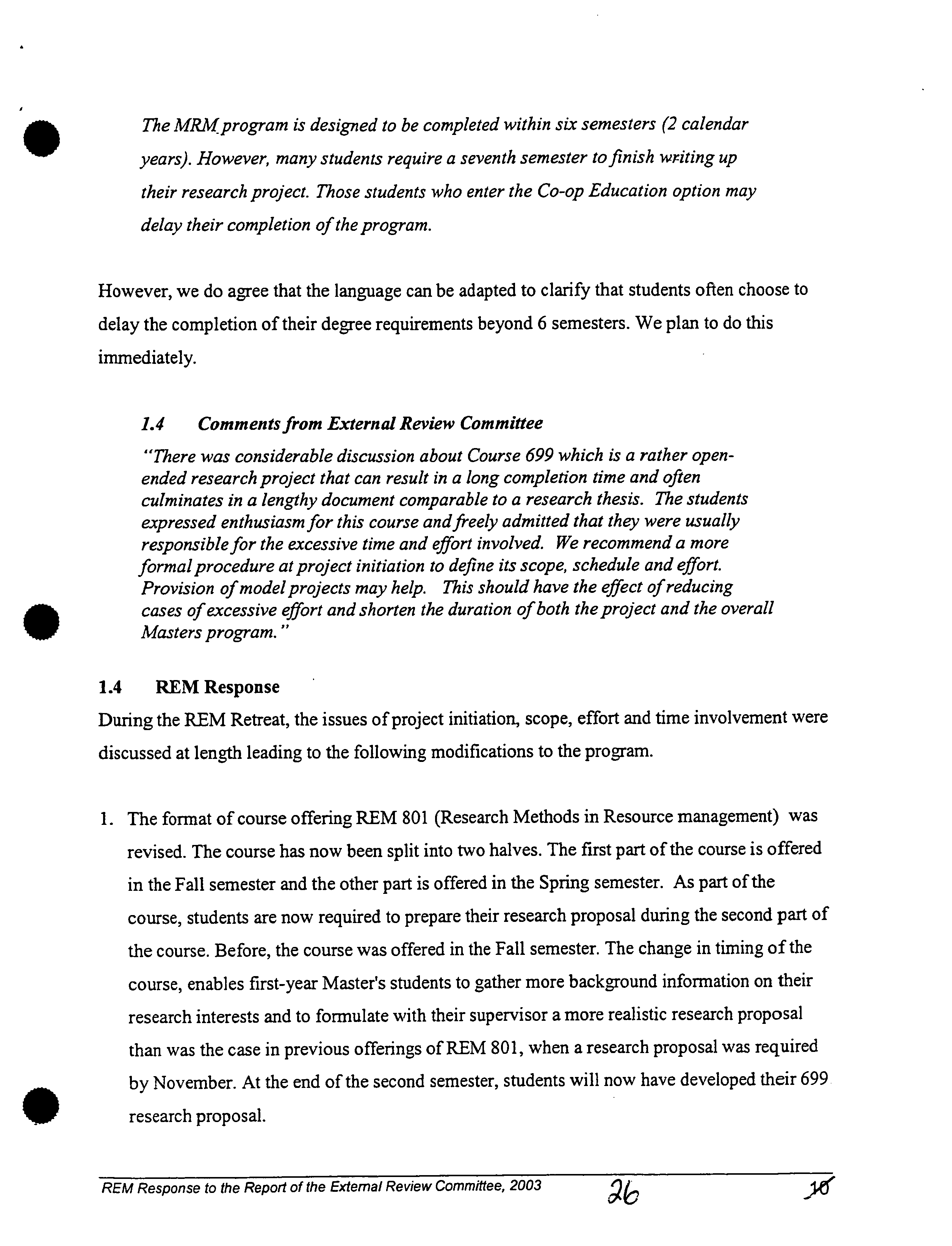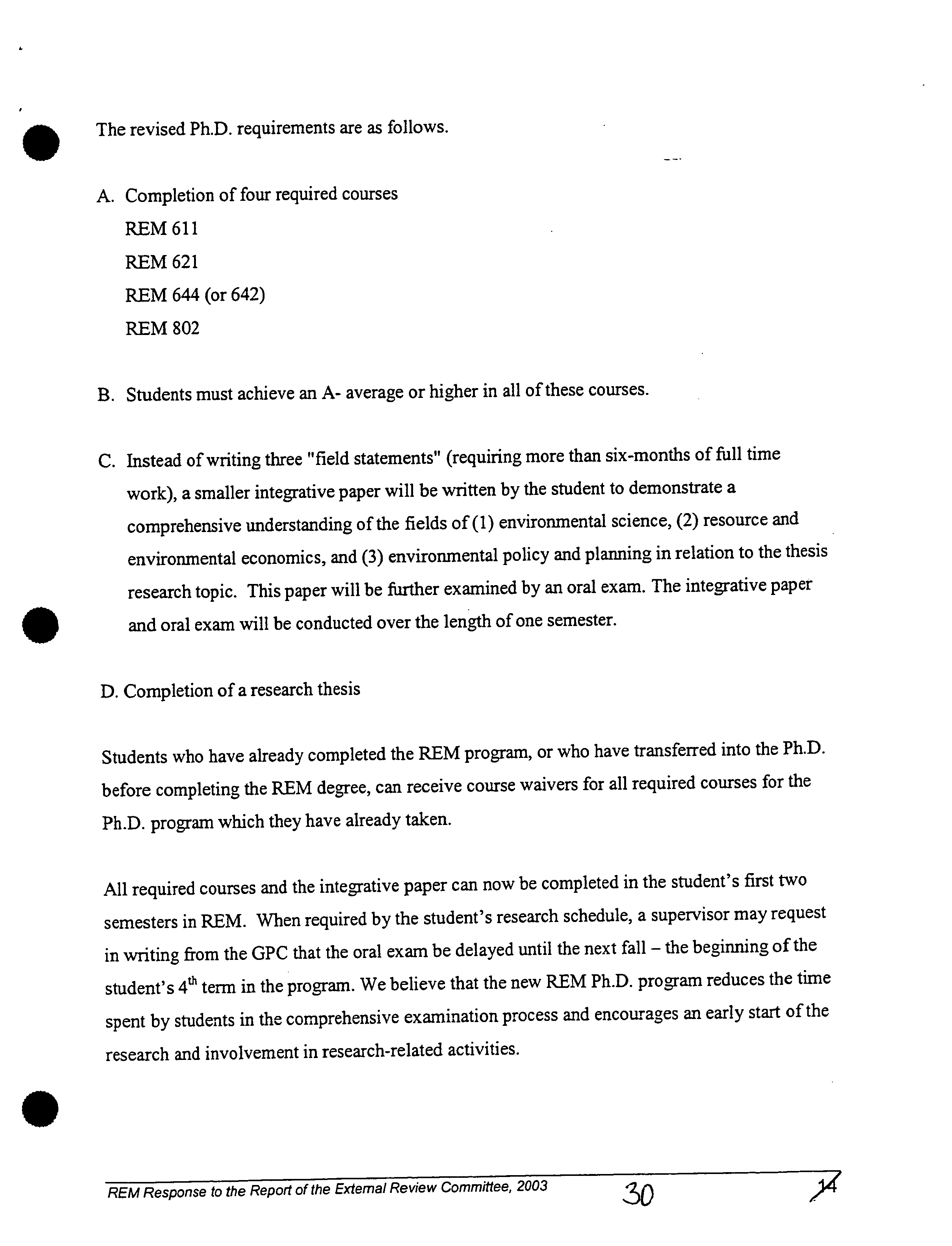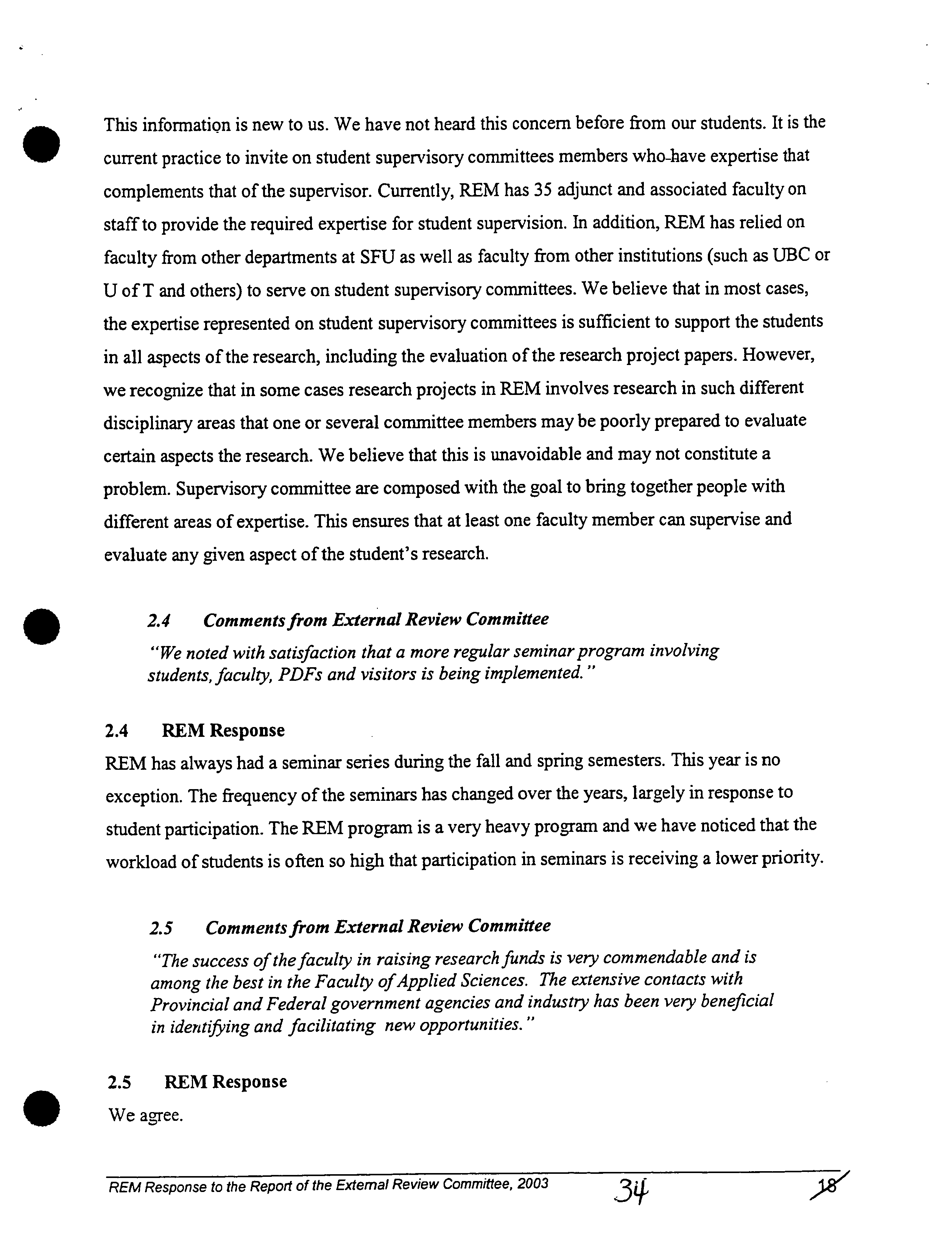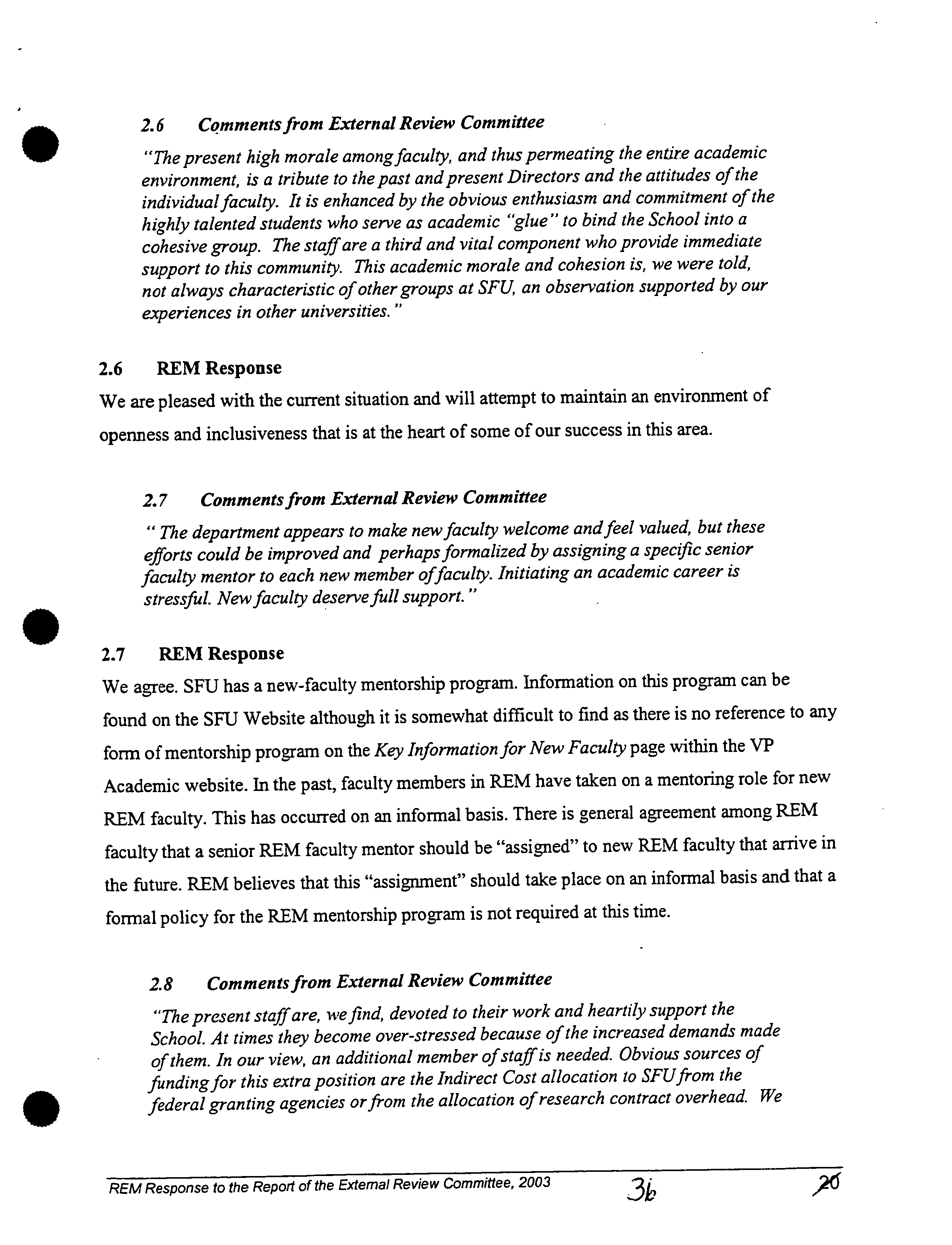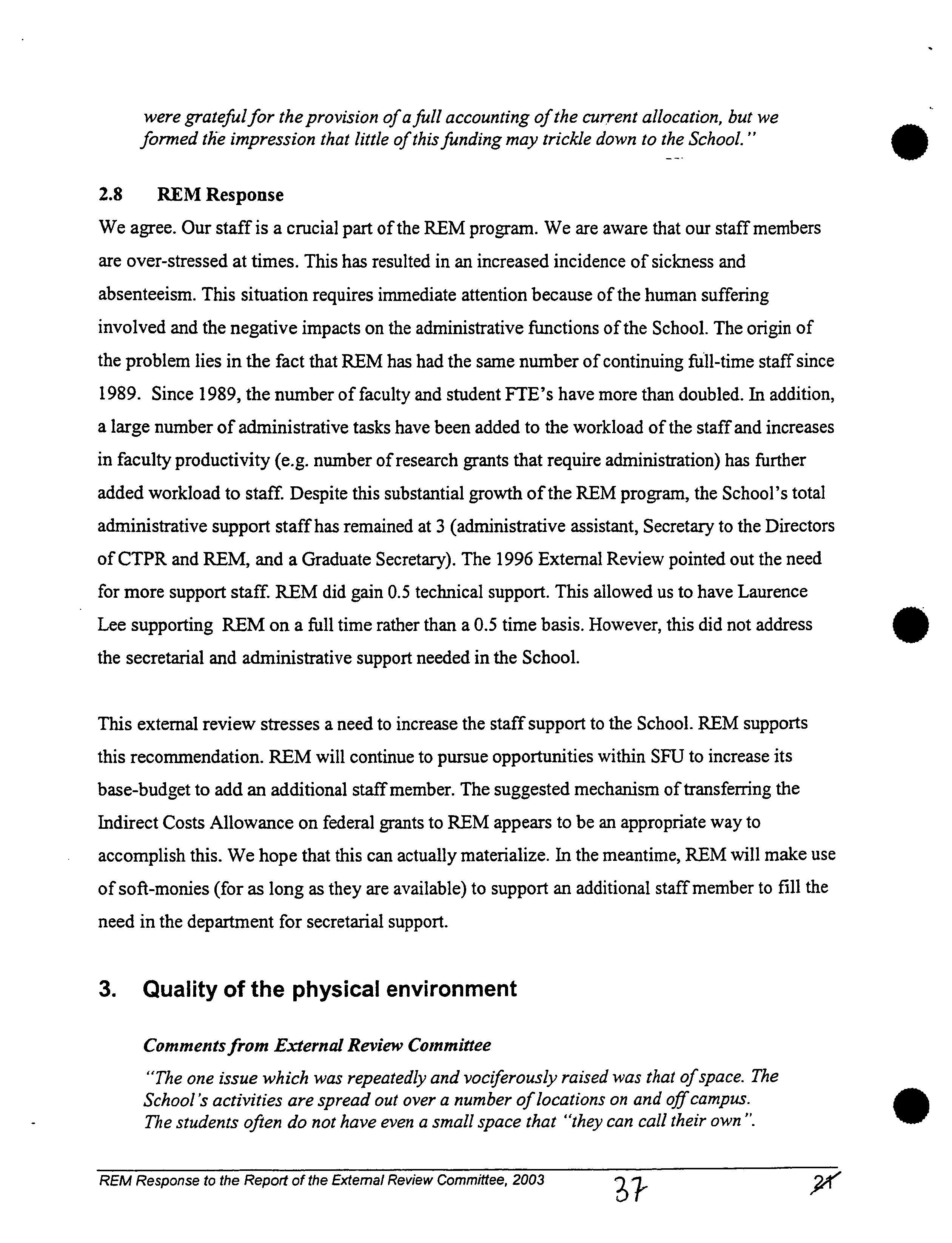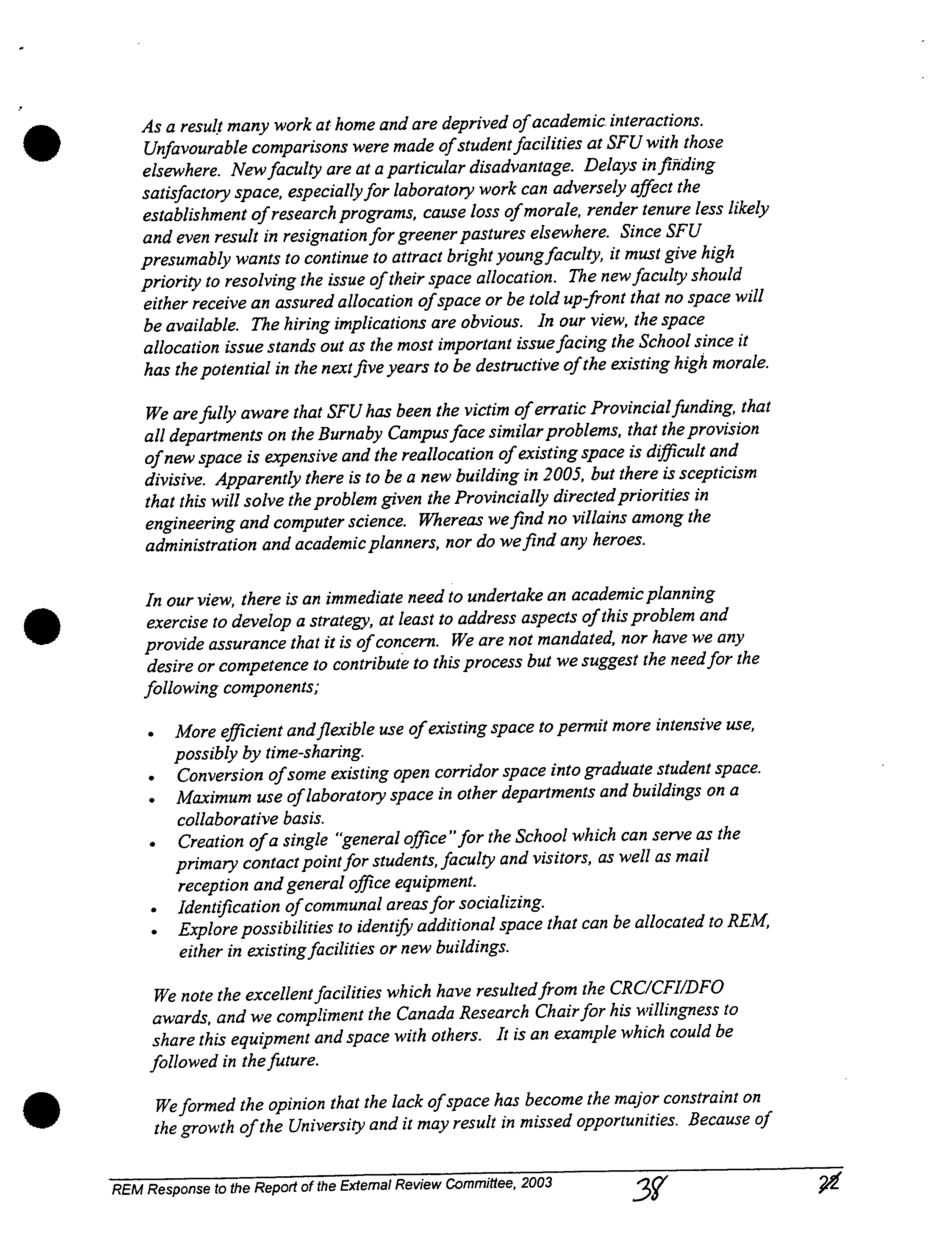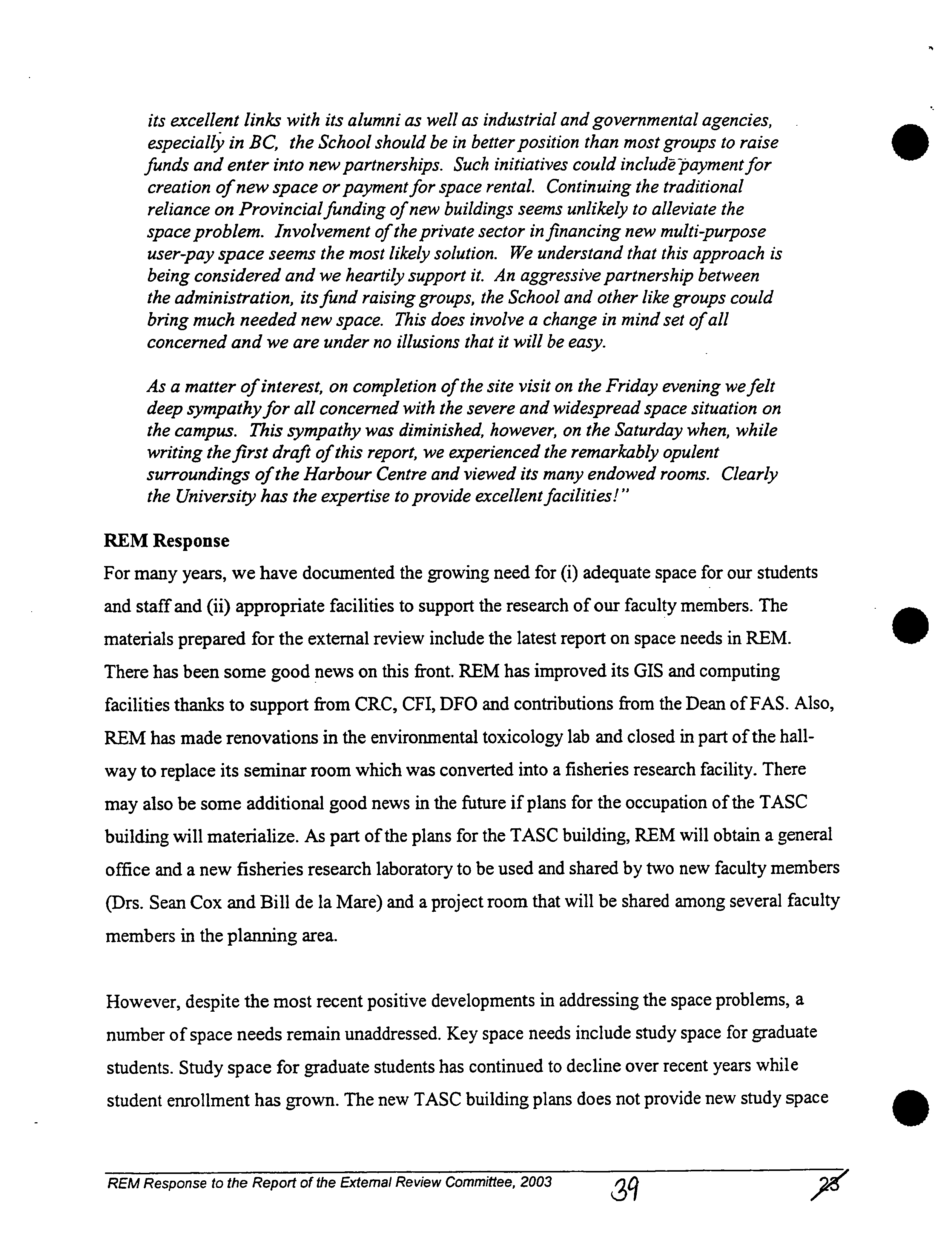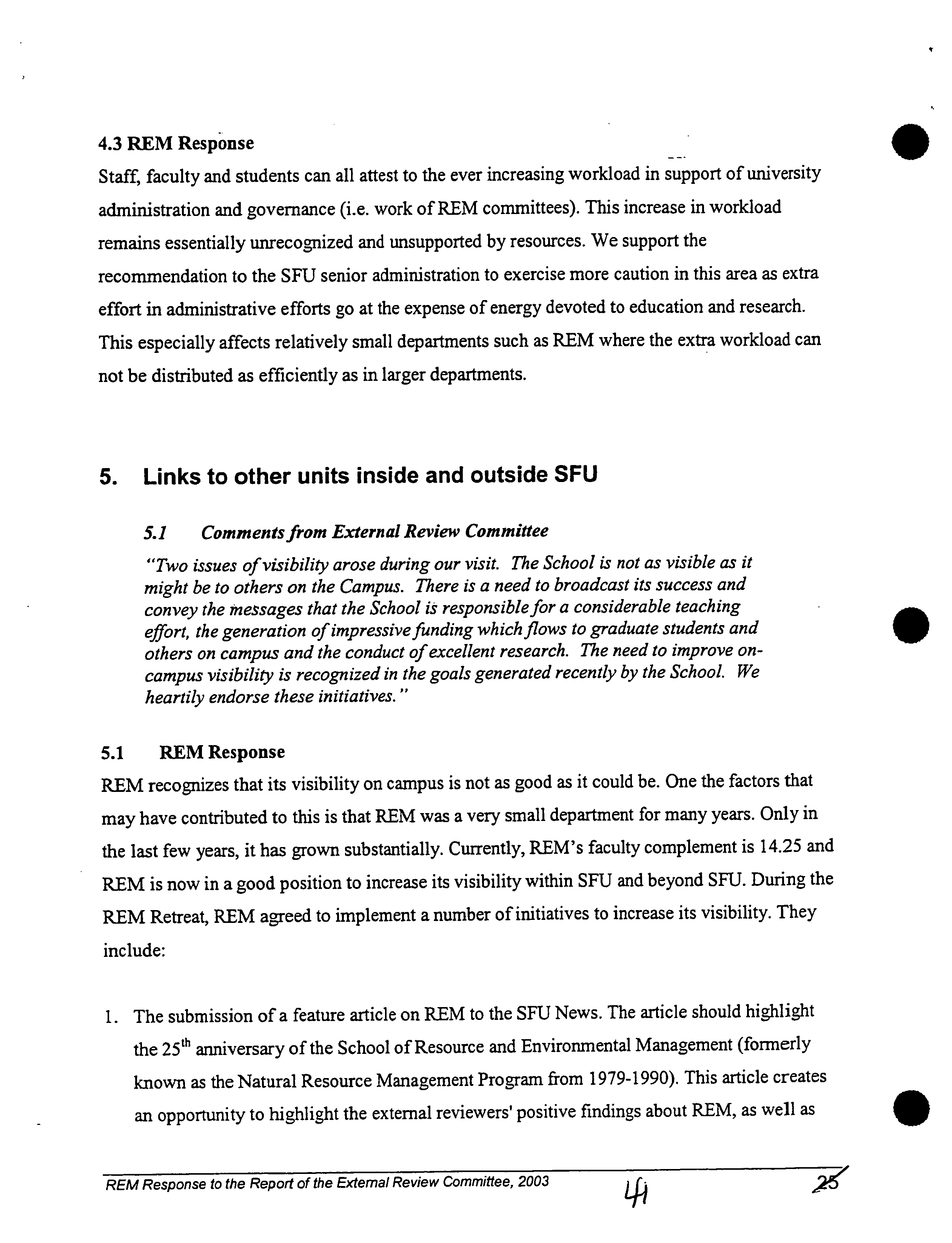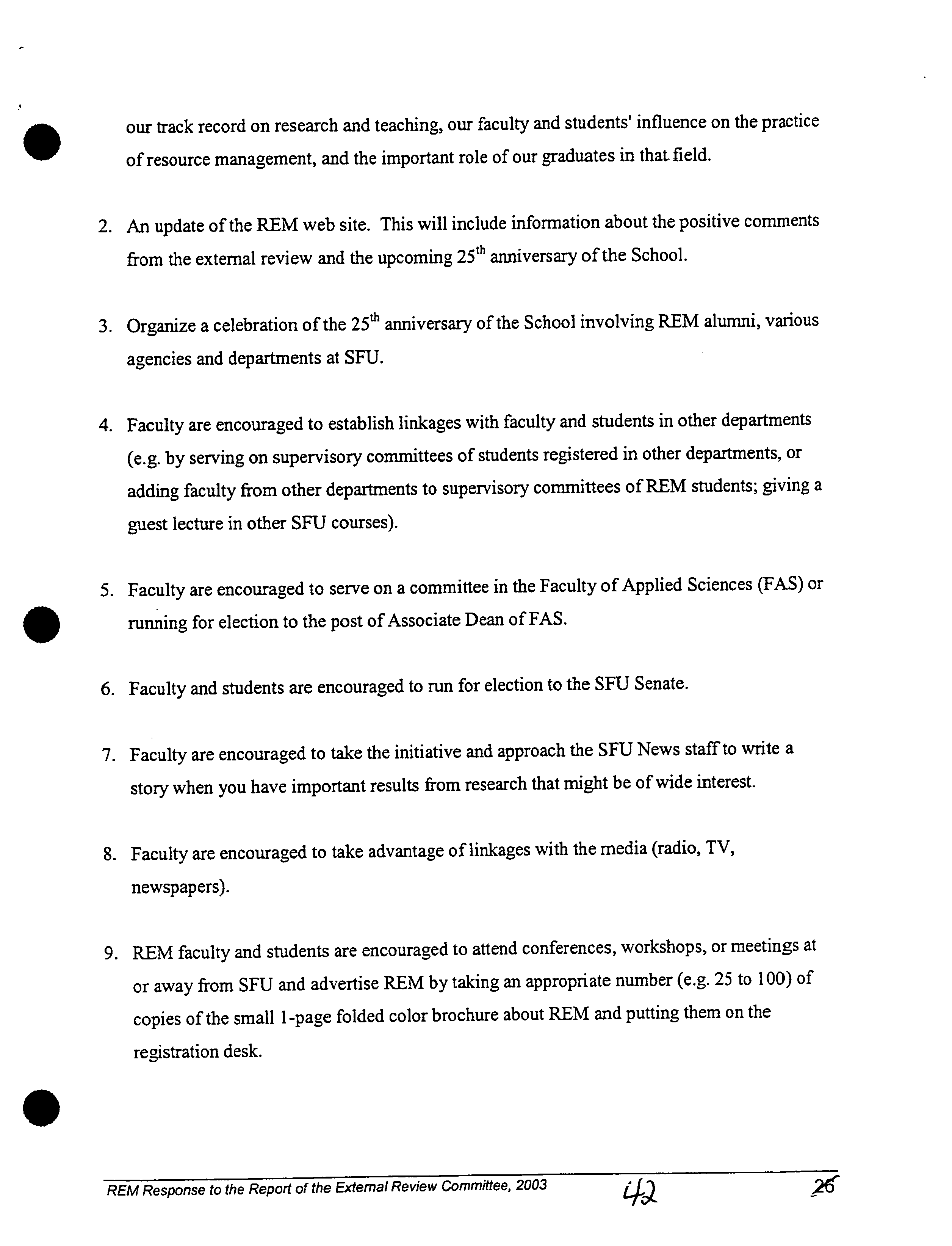
S
?
SIMON FRASER UNIVERSITY
Senate Committee on University Priorities
?
Memorandum
S.04-16
TO: Senate
RE:
School of Resource and
Environmental Management
External Review
FROM:
John Waterh
Chair, SCUP
Vice Preside
DATE: January 30, 2
S
.
The Senate Committee on University Priorities (SCUP) has reviewed the
External Review Report on the School of Resource and Environmental
Management together with the response from the School and comments from
the Dean of Applied Sciences.
Motion:
That Senate concurs with the recommendations from the Senate
Committee on University Priorities concerning advice to the School of
Resource and Environmental Management on priority items resulting
from the external review as outlined in S.04-16
The report of the External Review Committee for the School of Resource and
Environmental Management was submitted on April 22, 2003 following the
review site visit March 19 - 21, 2003. The response of the School was received
on October 1, 2003 followed by that of the Dean of Applied Sciences on
November
17,
2003.
SCUP recommends to Senate that the School of Resource and Environmental
Management and the Dean of Applied Sciences be advised to pursue the
following as priority items:
Graduate Programs
The External Review Team raised a variety of issues and concerns in relation to
the Master of Resource Management Program. These concerns were related to
sessional instruction, the MRM research project, PhD requirements, and letter
grades and numerical marks. The School appears to have already undertaken a
thorough assessment of the issues and taken steps to implement solutions as
necessary. The External Review Team's report has also raised awareness
around the issues of course load, completion times and admissions issues. The
School isadvised to continue to monitor any concerns as they arise and address
them as needed.
Facuy
SCUP recommends that issues around the management of research centres,
faculty mentorship, gender equity and student supervision should continue to be
monitored and where required be addressed by the School.
Space
SCUP advises the School to continue to work with the Dean as well as the
University Administration to assess space requirements for its teaching,
research, student and administrative needs.
Links to Other Units Inside and Outside SFU
SCUP urges the School to work towards enhancing its interactions and ties with
the internal and external community and alumni and to implement its proposed
plans to create these new opportunities and directions.
?
40
Future Plans and Visions
The School is encouraged to develop research and teaching programs that are
relevant to the management of cultural resources.
C. ?
Brian Lewis
Frank Gobas
2
. ?
SCUP O4-003
External Review of the ?
School of Resource and Environmental Management ?
of?
Simon Fraser University ?
March 2003
Conducted by ?
Dr. Gordon Baskerville
?
Consultant in Forest Management, ?
Retired Head, Department of Forest Management, UBC
Dr. Fay Cohen
?
School for Resource and Environmental Studies,
?
Sociology and Social Anthropology,
?
International Development Studies, ?
Community Health and Epidemiology,
?
Dalhousie University
Dr. Don Mackay (Chair)
?
Canadian Environmental Modelling Centre
?
Environmental and Resource Studies, Trent University
.
:3
2.
Executive Summary
This external review was conducted from March 19-21, 2003 in response to a request from Dr.
William R. Krane, Associate Vice President, Academic. The previous review was in 1995.
Extensive documentation was received by the Review Committee in advance of the visit to the
Simon Fraser Campus. The Committee met with administrators, faculty, staff, students, alumni,
librarians and had telephone conversations with employers. On the basis of the information
provided, the Committee finds itself competent to comment on the various aspects of the
School's performance as specified in the Senate Guidelines and on other specific issues raised by
the University and the School. The major conclusions and comments are summarized as follows.
We find that the quality of the graduate and undergraduate teaching programs is high.
Mechanisms are available to effect changes when needed and an effective evaluation system is in
place. We do, however, recommend that further attention be devoted to the issue of extended
completion times for the MRM degree. In particular, the course load is very heavy and the
Research Project may become excessively long. This causes a delay in completion to an average
of over ten semesters. This is a long residence when compared to the much shorter times at other
universities. We suggest a more vigorous approach to limiting the scope of the Research Project
(699) to assist in meeting a shorter completion time. The PhD program has grown significantly
from 4 students in 1995 to 14 students in 2002. We note that the Graduate Studies Committee is
currently considering the format of the PhD including the nature of requirements and flow of
workload. We encourage this examination, since we believe that improvements are desirable.
Specifically, we suggest that the average MRM completion time of 10.6 semesters be reduced to
about 8 semesters and a corresponding target be set for the PhD program.
The quality of the faculty and their research output is impressive. There is effective collaboration
where it is needed. Morale is very high and faculty-student-staff relationships are remarkably
cordial and collegial. An excellent learning atmosphere exists. We saw no evidence of cliques
or rivalries which, regrettably, are often present in the academic world.
U-
The arrangements concerning governance are, we find, appropriate and effective. Relationships
with administrators in the Faculty, the Graduate School and Research Administration are good,
reflecting mutual respect and collegiality.
We were deeply impressed by the enthusiasm of the students and the collegial atmosphere which
they greatly enjoy, and perhaps understandably prolong excessively. The students are a very
select group; they are highly motivated and self-demanding. These characteristics enable them to
survive and even enjoy the very heavy course load. The load should be such that they have time
to enjoy and reflect on non-prescribed issues. We have concerns that in some cases individuals
may
approach the "breaking point".
There is a need to increase the staff support to the School since the present staff are over-worked
and at times (such as preparing for an external review) are over-stressed. One additional person
I*
is needed. Offices could be more effectively consolidated.
The major issue threatening the quality of the program is space for graduate students, faculty
(especially new faculty) and staff. The present space allocation is inadequate in total area and it
is badly fragmented. This has a negative impact on the quality of several aspects of the academic
environment. In the report we elaborate on this difficult issue and offer suggestions.
The present program works well, it produces high quality graduates who fill a much needed
niche. It fulfills both a teaching/training function and a research function in environmental and
resource issues. We do not recommend any significant changes to the structure or to the size of
the faculty or student number. Growth of the order of 10% but no more than 20% in the next
seven years is, in our view, appropriate. The School has achieved a critical mass. It would suffer
if numbers were reduced. It could suffer if numbers were greatly expanded since interdisciplinary
cooperation would likely deteriorate. In total, we find that the University has an excellent School
of Resource and Environmental Management; among the best in Canada.
.
4
Quality, conduct and content of teaching programs
?
- -.
The course requirements of the School are exceptionally heavy but they are tolerable and we
found reluctance from both the students and faculty to reduce the load. In large measure this is a
reflection of the high quality and motivation of the students who are a select group with a high
GPA. The acceptance rate is about one from every eight applicants. This rate is a reflection of
the high perceived quality of the program by applicants.
There was universal and consistent evidence that the teaching programs are high in quality and
that the graduates are well equipped to enter responsible positions in resource and environmental
management. The students expressed satisfaction and even enthusiasm for the core and elective
graduate courses. It was noted that the demands made of the students in individual courses and
collectively in terms of number of courses required are exceptional and may represent one of the
most intensive series of graduate courses in this subject area in Canada. Despite this heavy load,
the students were appreciative of the breadth, content and conduct of the courses, although it was
clear that in some cases the load became very stressful. The format of three courses per semester
is, we believe, a tolerable load, but we urge a degree of flexibility for certain students who, given
their backgrounds, may require extra assistance as a result of the broad multi-disciplinary nature
of the demands. The course evaluation process was regarded as effective and responsive.
Concern was expressed by the students, in some cases quite vociferously, on the quality of some
courses which were taught on a sessional basis. From time to time all Universities experience
difficulties finding qualified faculty to deliver all the required courses. Rather than find less-
than-satisfactory replacements, consideration should be given to postponing the course for a year
until fully qualified faculty are available.
A concern is the average, median and range of completion times for the Masters Program. An
average of 10.6 semesters (as quoted in the "Graduate Studies Fact Book") seems excessive.
Current completion times may be shorter and we appreciate that some students take up
employment before completion. The literature provided to prospective students conveys an
?
0
c
in
. ?
5
impression that the program is expected to take two years and in some caës somewhat longer.
In reality, the average completion time is over three years. This mis-statement should be
corrected and more accurate information should be provided in the brochure and on the REM
website. Surprisingly the students did not complain about this situation and it is clear that this
long duration is not atypical in the University. In our view there is a strong case for reducing the
average MRM student residence time to about eight semesters and including an informal review
of those students who show signs of requiring more than nine semesters.
There was considerable discussion about Course 699 which is a rather open-ended research
project that can result in a long completion time and often culminates in a lengthy document
comparable to a research thesis. The students expressed enthusiasm for this course and freely
admitted that they were usually responsible for the excessive time and effort involved. We
recommend a more formal procedure at project initiation to define its scope, schedule and effort.
. ?
Provision of model projects may help. This should have the effect of reducing cases of
excessive effort and shorten the duration of both the project and the overall Masters program.
Some concerns were expressed about the Ph.D. program, which is relatively new and fills an
important need for interdisciplinary Ph.D. programs in the environmental field in Canada.
Particular items currently being discussed include the structure of the program (including the
breadth and depth of examinations) and the need to further promote a "cohort" among Ph.D.
students. Two comments made in the previous review have been addressed: there has been a
positive record of employment of graduates and a faculty member with experience in law has
been added. Also, current Ph.D. students and Ph.D. graduates who participated in our review
sessions were very enthusiastic about the program. Rather than make any specific
recommendations during this time of early evolution, we believe that additional examination
would be more useful several years from now.
We do note, however, that PhD graduates who seek an academic or research career need to
demonstrate the ability to undertake and publish independent research of both quality and
I
6
quantity. We are concerned that REM graduates may be at a disadvantagecompared to graduates
of other institutions in which the PhD student is expected to devote most effort to research, the
resulting presentations and refereed journal publications. We recommend that the committee
pay particular attention to the time frame and various steps in completing the PhD program in
order to promote optimal time for research and publication during the program.
We note that although the School is very successful in attracting high quality students there is an
expectation that there will be increased competition from other universities which can offer
shorter programs and better financial support. This changing situation merits close monitoring.
The School is involved in the Undergraduate program by teaching six courses. We are persuaded
that this effort is justified on the basis that it provides visibility to the School among
undergraduates, it provides opportunities for teaching assistantships and most importantly it
exposes undergraduates to faculty of high quality and reputation in the resource and
environmental fields. There is, we believe, no case for either increasing or reducing this effort.
It has achieved a satisfactory balance. We were not able to comment on evaluations of these
courses by undergraduate students.
The Cooperative program appears to be well conceived and operated. Numbers are limited by
student demand. It is valuable as a means of exposing students to "real world" issues.
To our surprise, we found that at present the University and the School appear to have no
standardized system for the correspondence between numerical marks and letter grades. With
care not to infringe on academic freedom, it would be beneficial to both faculty and students for a
clearer system to be agreed-upon and used consistently within REM. This is especially important
when SFU grades are assessed by other institutions and funding agencies such as the Granting
Councils and graduates find themselves in competition with others.
0
7
7
S
Quality of the faculty
The quality of the faculty and their research programs is clearly high. Morale is excellent and
there is a good level of cooperation, especially in the form of groups or "Centres" which focus on
specific areas such as fisheries, tourism and energy studies. In our experience, on other
campuses the merits of interdisciplinary collaborations are often more perceived than real and in
many cases there is no compelling incentive for collaboration given the depth of individual
disciplinary activities. The level of collaboration at the School is good and leaves little
opportunity for increase.
At some universities there can be a proliferation of Centres that are created in response to
funding opportunities and individual enthusiasms and that do not cooperate as much as is
desirable. This can create a negative perception from off-campus. We wonder if SFU is
vulnerable to this problem, for example in fisheries with groups in REM, the Centre in Coastal
•
?
Studies and DFO groups in Marine Environment and Habitat Science which operate in
conjunction with the Cooperative Resource Management Institute.
Concern was expressed by the students that their papers on topics outside their supervisor's
immediate disciplinary area were not always fully appreciated by these supervisors. Given the
heavy teaching and research load this is understandable and perhaps forgivable. We suggest that
faculty consider inviting a second reader to review papers on topics outside their fields and then
confer with this second reader as part of the evaluation process.
We noted with satisfaction that a more regular seminar program involving students, faculty,
PDFs and visitors is being implemented.
The success of the faculty in raising research funds is very commendable and is among the best
in the Faculty of Applied Sciences. The extensive contacts with Provincial and Federal
government agencies and industry has been very beneficial in identifying and facilitating new
5 ?
opportunities.
8
The present high morale among faculty, and thus permeating the entire academic environment, is
a tribute to the past and present Directors and the attitudes of the individual faculty. It is
enhanced by the obvious enthusiasm and commitment of the highly talented students who serve
as academic "glue" to bind the School into a cohesive group. The staff are a third and vital
component who provide immediate support to this community. This academic morale and
cohesion is, we were told, not always characteristic of other groups at SFU, an observation
supported by our experiences in other universities.
The department appears to make new faculty welcome and feel valued, but these efforts could be
improved and perhaps formalized by assigning a specific senior faculty mentor to each new
member of faculty. Initiating an academic career is stressful. New faculty deserve full support.
The present staff are, we find, devoted to their work and heartily support the School. At times
they become over-stressed because of the increased demands made of them. In our view, an
additional member of staff is needed. Obvious sources of funding for this extra position are the
Indirect Cost allocation to SFU from the federal granting agencies or from the allocation of
research contract overhead. We were grateful for the provision of a full accounting of the current
allocation, but we formed the impression that little of this funding may trickle down to the
School.
If there is one issue which can erode this very desirable state, it is frustration and possible
conflict over the physical environment, i.e. space and its allocation. We now address this issue.
Quality of the physical environment
The one issue which was repeatedly and vociferously raised was that of space. The School's
activities are spread out over a number of locations on and off campus. The students often do not
have even a small space that "they can call their own". As a result many work at home and are
deprived of academic interactions. Unfavourable comparisons were made of student facilities at
10
. ?
9
SFU with those elsewhere. New faculty are at a particular disadvantage. Delays in finding
satisfactory space, especially
for
laboratory work can adversely
affect
the establishment of
research programs, cause loss of morale, render tenure less likely and even result in resignation
for greener pastures elsewhere. Since SFU presumably wants to continue to attract bright young
faculty, it must give high priority to resolving the issue of their space allocation. The new faculty
should either receive an assured allocation of space or be told up-front that no space will be
available. The hiring implications are obvious. In our view, the space allocation issue stands
out as the most important issue facing the School since it has the potential in the next five years
to be destructive of the existing high morale.
We are fully aware that SFU has been the victim of erratic Provincial funding, that all
departments on the Burnaby Campus face similar problems, that the provision of new space is
expensive and the reallocation of existing space is difficult and divisive. Apparently there is to
be a new building in 2005, but there is scepticism that this will solve the problem given the
Provincially directed priorities in engineering and computer science. Whereas we find no villains
among the administration and academic planners, nor do we find any heros.
In our view, there is an immediate need to undertake an academic planning exercise to develop
a strategy, at least to address aspects of this problem and provide assurance that it is of concern.
We are not mandated, nor have we any desire or competence to contribute to this process but we
suggest the need for the following components;
More efficient and flexible use of existing space to permit more intensive use, possibly by
time-sharing.
Conversion of some existing open corridor space into graduate student space.
Maximum use of laboratory space in other departments and buildings on a collaborative
basis.
Creation of a single "general office" for the School which can serve as the primary
contact point for students, faculty and visitors, as well as mail reception and general
40
?
office equipment.
10
Identification of communal areas for socializing.
Explore possibilities to identify additional space that can be allocated to REM, either in
existing facilities or new buildings.
We note the excellent facilities which have resulted from the CRC/CFJJDFO awards, and we
compliment the Canada Research Chair for his willingness to share this equipment and space
with others. It is an example which could be followed in the future.
We formed the opinion that the lack of space has become the major constraint on the growth of
the University and it may result in missed opportunities. Because of its excellent links with its
alumni as well as industrial and governmental agencies, especially in BC, the School should be
in better position than most groups to raise funds and enter into new partnerships. Such
initiatives could include payment for creation of new space or payment for space rental.
Continuing the traditional reliance on Provincial funding of new buildings seems unlikely to
alleviate the space problem. Involvement of the private sector in financing new multi-purpose
user-pay space seems the most likely solution. We understand that this approach is being
considered and we heartily support it. An aggressive partnership between the administration, its
fund raising groups, the School and other like groups could bring much needed new space. This
does involve a change in mind set of all concerned and we are under no illusions that it will be
easy.
As a matter of interest, on completion of the site visit on the Friday evening we felt deep
sympathy for all concerned with the severe and widespread space situation on the campus. This
sympathy was diminished, however, on the Saturday when, while writing the first draft of this
report, we experienced the remarkably opulent surroundings of the Harbour Centre and viewed
its many endowed rooms. Clearly the University has the expertise to provide excellent facilities!
Governance
We find that the School is well administered. It has an appropriate structure with adequate
representation. It was clear that the graduate studies and undergraduate studies committees were
S
Id
S.
fully aware of areas requiring attention and had thought through solution Relationships with the
administration are good and reflect competent management by the School.
The previous review suggested having an External Advisory Committee. On balance we do not
favour creating such a Committee. If it is to be done it must be done well and fully justify its
existence to external members. Too often such advisory groups fail to achieve pragmatic
improvements, leaving all concerned dissatisfied.
We did hear concerns about increasing levels of "administrivia". All institutions suffer from
internal pressures to increase demands for data information and paperwork. We urge the
administration to exercise continued vigilance to ensure that such demands are made only when
really essential.
S ?
Links to other units inside and outside SFU.
Two issues of visibility arose during our visit. The School is not as visible as it might be to
others on the Campus. There is a need to broadcast its success and convey the messages that the
School is responsible for a considerable teaching effort, the generation of impressive funding
which flows to graduate students and others on campus and the conduct of excellent research.
The need to improve on-campus visibility is recognized in the goals generated recently by the
School. We heartily endorse these initiatives.
Second, we believe that the reputation of SFU in the Province, in Canada and internationally is
largely determined by the visibility of its graduate level research. Unfortunately, excellent
undergraduate teaching is not newsworthy! Grant applications routinely require a statement of
significant contributions and their impacts. A collection of such "statements of impact" could be
a valuable source of publicity and generate greater visibility.
The School provided an impressive list of alumni and we discussed the School's activities with
several alumni in person and by telephone. We were left with the impression that there was a
6
• ?
12
need for more exploitation of these valuable contacts. A periodic newsleitèr to all alumni would
be a useful method of maintaining contact, interest and involvement.
Individual faculty are involved in a variety of public service functions. Such service is
invaluable and should be encouraged and recognized.
Future plans and visions
REM's future plans include increased activity in the area of native studies, including pursuit of
hiring a CRC Tier II
Chair in Native Studies in collaboration with the Department of Archeology
and a BC Leadership Chair in Native Governance. These initiatives are viewed as positive in
several respects. Over the years, REM faculty, graduates, and students have worked with First
Nations communities in various capacities. This background and experience, complemented by
new appointments, would enable REM to be an appropriate and constructive partner with
Aboriginal people and communities engaged in post-graduate training and capacity-building.
Aboriginal involvement in resource management in BC specifically and Canada as a whole can
be expected to gain even greater prominence in future, and thus the REM/SFU initiative should
be supported.
The committee noticed that women and other employment equity groups are under-represented
among the faculty cohort, with one full time, one half time and one quarter time female member
of faculty among a 14.25. cohort. Increased representation would be desirable both for equity
(balance) purposes and to provide diverse role models to students. We understand that some
efforts have been made in recent years to improve the balance, but that these were not successful.
In the absence of any imminent retirements, REM should strive to fill any vacancies caused by
current faculty departures and to attract diverse PDFs to improve this situation, as well as
encourage and support its existing female faculty.
The School provided us with an impressive list of goals. We support these goals but suggest that
priorities be assigned to them.
?
is
1.,
1.)
Acknowledgments
Finally, we wish to thank all those from SFU who provided us with the information and
assistance which made our task easier and more enjoyable. We were treated with unfailing
hospitality. The students, faculty and staff of the School were very cordial and helpful. Opinions
were expressed openly and frankly. In particular we thank Laurie Summers, Frank Gobas and
Carl Schwarz for guiding us through the maze of procedures, practices and passageways of SFU
during our visit. We thank Ness Mackay for her assistance in assembling this report. It was a
rewarding experience for us and we hope that these thoughts will be of value to the School and
the University.
.
.
/
SOUP 04-003
MEMORANDUM
SIMON FRASER UNIVERSITY
FACULTY OF APPLIED SCIENCES
DATE:
November 14, 2003
TO:
?
Bill Krane, Associate Vice-President Academic
FROM:
Brian Lewis, Dean, Faculty of Applied Sciences
RE: ?
External Review - School of Resource and Environmental Management
The External Review Committee strongly supports the current programs and directions of the
School of Resource and Environmental Management (REM). This support is based on an
assessment of student satisfaction, teaching quality, research productivity, morale, governance,
academic relevance, and the importance of the program to professional communities.
REM offers a high quality and well-run professional graduate program. REM has been able to
attract excellent students and the Masters in Resource Management (MRM) is respected
nationally. Faculty have substantial contacts in professional communities, and they provide
significant training opportunities for their students.
. ?
Most of the more minor concerns listed in the report, including issues around the assignment of
courses, minor curriculum revisions, faculty mentorship, and communication with external and
internal communities are being addressed by REM in an appropriate and timely matter.
I support REM's new initiatives in the area of Native Studies, including a joint CRC Tier II. A
Chair and a possible Institute in Aboriginal Governance are important development
opportunities for the Faculty of Applied Sciences.
I agree with the Committee that the gender imbalance in the faculty cohort must be addressed,
and that the disciplines covered by REM should make this achievable as vacancies occur.
Issues of course load and completion time are addressed in some detail in the report. The
MRM requires a high number of courses relative to other graduate programs in FAS and across
the University. The Committee notes a reluctance to change this course load -as expressed
both by students and faculty members. REM argues the necessity of its approach on the basis
of the depth, breadth and professional requirements needed for professional resource managers.
Students, generally, do not seem to be complaining.
REM is restructuring elements of certain key courses (801 and 699) to assure early
identification and development of research projects, and it is making administrative changes
which can help to assure timely progress through the degree, appropriate scope and supervision.
The Committee expressed concerns that PhD students are not being afforded adequate time for
research, presentation and publication activity. REM is revising course requirements and
examination requirements in response to these concerns.
Other major concerns of the report revolve around graduate student support, inadequate space
and support staff.
.
ft2
Page 2
REM students are supported by RAships from their supervisors, a limited number of TAships,
FAS Graduate Fellowships, FAS RAs (NSERC top-ups), and University Graduate
Fellowships. Essentially, the graduate funding pool remains limited by the smaller TA budget,
which is tied to the service courses REM teaches for other programs.
Support staff are critical to the efficient running of our units. I recognize that REM and other
Schools in the Faculty could use additional resources. We have this year been able to use
significant funds from the Indirect Costs of Research Program to fund staff in support of
research activities within REM.
REM will benefit, as will most units in FAS, from the new building (TASC 1 or DTO
Building). Because REM will be moving into the new space, efficiencies and designs will partly
alleviate the current space crunch. A major research group will be reintegrated with the School,
and I have been able to secure an additional 1,000 sq. ft. in the new Cornerstone building,
increasing REM' s overall allotment.
The University is putting more resources into development and fundraising. REM's success in
attracting significant research funding and funding for Chairs bodes well for future initiatives
targeting external sources to help meet its infrastructure needs.
The School and its faculty incur both benefits and liabilities as a result of the fact that there is
no undergraduate program in REM. Recommendation 1.7 of the External Review Committee
addresses this question directly. I see some irony in this recommendation: while it admits that
the package of six undergraduate service courses taught by REM are "justified on the basis that
it provides visibility to the School among undergraduates, it provides opportunities for teaching
assistantship and most importantly it exposes undergraduates to faculty of high quality in.. .the
resource and environmental fields," the report goes on to say, "There is, we believe, no case
for either increasing or reducing this effort."
REM cannot easily participate in increasingly significant funding programs which are based on
servicing undergraduate FTEs: DTO, base-budget funding tied to reducing faculty:FTE ratios,
funding tied to attracting international undergraduate students, and one-time funding tied to
reducing course turnaways, etc.
An undergraduate program in Resource and Environmental Management was approved by
Senate in 1996. It may be time to revisit this situation. REM has developed an outstanding
graduate program. Its continued strength and development could be enhanced by the
development of a strong, foundational undergraduate program. I would work with the School
and the Administration to assess the current disciplinary needs for such a program, and work to
make it a reality if that case can be made.
REM's interdisciplinary and integrative approach continues to provide exception value to its
students, the Canadian academic community and professional communities in resource and
environmental management. The Report of the External Examiners underlines this reality.
I
Brian Lewis
Dean
Faculty of Applied Sciences
BMc
?
iJ
cc: F. Gobas, Director, School of Resource and Environmental Management
SCUP O4-003
SCHOOL of RESOURCE
&
ENVIRONMENTAL MANAGEMENT
RESPONSE ?
to the
?
REPORT of the EXTERNAL REVIEW COMMITTEE
?
on
?
the SCHOOL of RESOURCE
&
ENVIRONMENTAL MANAGEMENT
Prepared by: Frank Gobas, Director
?
September 25, 2003
ig
INTRODUCTION
The School of Resource and Environmental Management (REM) was visited by an External
Review Committee review committee over a period of three days from March 19 to 21, 2003.
The committee consisted of Dr. Don Mackay (Chair of Review Team), Dr. Fay Cohen,
Dr. Gordon Baskerville, and Dr. Carl Schwarz (Internal Reviewer). During their review, the
committee visited with faculty, staff, students and REM alumni, as well as with members of the
senior administration of the University. The committee performed their duties in a highly
professional, effective and thorough manner.
The External Review Committee produced a written report which was received by REM in April
2003. The report provides a detailed review of the School's activities and performance as well
as some constructive ideas and view points. The report was widely distributed in REM, the
faculty of Applied Sciences and Simon Fraser University. The findings of the report were
discussed in the School's Retreat, which was held on June 10-11, 2003. The goals of the Retreat
were to (i) formulate a response to all comments, criticisms and advice put forward in the
external reviewers' report and (ii) to change or modify the strategic plan of REM.
As part of the Retreat, all issues and recommendations that required a response were identified.
This document summarizes the response of REM to the comments and recommendations
outlined in the review committee's report. Following the format chosen by the review
committee we have addressed each comment in the order presented in the report. Comments
made in the review committee's report are represented in quotes and italics. REM's response to
those comments are presented in regular type face.
.
REM Response to the Report of the External Review Committee, 2003
?
/4? ?
Ia'
.
CONTENTS
1.
Quality, conduct and content of teaching programs ............................................ 5
2.
Quality of the faculty............................................................................................17
3.
Quality of the physical environment...................................................................21
4.
Governance...........................................................................................................24
5.
Links to other units inside and outside SFU......................................................25
9 ?
6. ?
Future plans and visions .....................................................................................28
REM Response to the Report of the External Review Committee, 2003
?
o
1. ?
Quality, conduct and content of teaching programs
1.1 ?
Comments from External Review Committee
"The course requirements of the School are exceptionally heavy but they are
tolerable and we found reluctance from both the students and faculty to reduce the
load. In large measure this is a reflection of the high quality and motivation of the
students who are a select group with a high GPA. The acceptance rate is about one
from every eight applicants. This rate is a reflection of the high perceived quality
of the program by applicants.
There was universal and consistent evidence that the teaching programs are high in
quality and that the graduates are well equipped to enter responsible positions in
resource and environmental management. The students expressed satisfaction and
even enthusiasm for the core and elective graduate courses. It was noted that the
demands made of the students in individual courses and collectively in terms of
number of courses required are exceptional and may represent one of the most
intensive series ofgraduate courses in this subject area in Canada. Despite this
heavy load, the students were appreciative of the breadth, content and conduct of
the courses, although it was clear that in some cases the load became very stressful.
The format of three courses per semester is, we believe, a tolerable load, but we
urge a degree offlexibilily for certain students who, given their backgrounds, may
require extra assistance as a result of the broad multi-disciplinary nature of the
demands. The course evaluation process was regarded as effective and
responsive."
1.1 REM Response
We are pleased to hear that the external review committee found the teaching programs to be of
high quality and that REM graduates are well equipped to enter responsible positions in resource
and environmental management. We are also pleased to have confirmed that that our students are
generally satisfied and enthusiastic about the REM program.
We agree that the REM program is a demanding program. The program contains a total of 12
courses, an introductory field course and a 2 semester research project. The rationale for the
structure of the program is based on the professional requirements of resource managers.
Resource managers typically deal with a large range of issues ranging from social, scientific to
economic. In our view, resource managers require a strong background in these areas. Hence the
core courses emphasize economics, policy and/or planning, social science, applied ecology and
geomorphology and research methods. This requires 6 courses. In addition, students require an
REM Response to the Report of the External Review Committee, 2003
in
?
area of specialization in order to be recruited for positions such as fisheries managers, wildlife
managers, energy planners, environmental managers etc. This requires another 6 courses where
students take optional courses in the large number of courses that we have available such as Law,
forest ecology, environmental toxicology, fisheries management, modeling and others. The
requirement for a research project is crucial as most resource management activities involve
research and students require experience in this area.
The structure of the REM program is not that different from that of some other professional
programs at SFU. For example the Masters in Environmental Toxicology Program also requires
12 courses and a 1-semester research project. The Masters in Pest Management Program requires
10 courses and a thesis.
Our experience is that the great majority of students find the recommended course load
feasible. This is partly the result of the fact that the REM students are a select group of
students with very strong academic track records. Those students who, given their
backgrounds or other circumstances require extra assistance or time to complete the
courses, have the option to choose the course load that is appropriate for them. The
student supervisor and supervisory committee can help with selecting an appropriate
course load.
1.2 Comments from External Review Committee
"Concern was expressed by the students, in some cases quite vociferously, on the
quality of some courses which were taught on a sessional basis. From time to time
all Universities experience difficulties finding qualified faculty to deliver all the
required courses. Rather than find less- than-satisfactory replacements,
consideration should be given to postponing the course for a year until
fully
qualified faculty are available."
1.2 REM Response
We are aware of this situation. The concern largely relates to one particular course, i.e. REM631.
Over the years, REM has been unable to recruit a regular REM faculty member to teach REM
631. REM63 1 has always been taught by sessional instructors, with variable outcomes. Dr.
Newburry has been an excellent sessional instructor for this course, but he has been unable to
REM
Response to the Report of the External Review Committee, 2003
?
fr'
teach the course over the last few years. More recently, we have been less fortunate in finding a
suitable sessional instructor.
?
-
During our recent Retreat, we have proposed that this course undergo a substantial shift in both
course content, format and instruction. It will become a general course in physical processes in
the environment and their manifestation in management problems. The core of geomorphology
and hydrology will remain, but the scale of processes considered will be expanded to include
both local ecosystem-scale and global-scale perspectives on geochemical cycling. In addition,
the course will address watershed management with a focus on how physical processes are dealt
with in policy and planning.
The course will have one or two REM faculty members responsible for its organization and
management. We will no longer rely on sessional instructors to teach this course. The course
will depend heavily on input from other REM faculty, faculty at SFU (e.g. from Earth Sciences),
and REM Adjunct faculty.
Subject to workload issues, Ken Lertzman, Dr. Frank Gobas and Dr. Murray Rutherford will be
taking the lead role in teaching this course.
1.3 Comments from External Review Committee
"A concern is the average, median and range of completion times for the Masters
Program. An average of 10.6 semesters (as quoted in the "Graduate Studies Fact
Book") seems excessive. Current completion times may be shorter and we
appreciate that some students take up employment before completion. The
literature provided to prospective students conveys an impression that the program
is expected to take two years and in some cases somewhat longer. In reality, the
average completion time is over three years. This mis-statement should be
corrected and more accurate information should be provided in the brochure and
on the REM webs ite. Surprisingly the students did not complain about this situation
and it is clear that this long duration is not atypical in the University. In our view
there is a strong case for reducing the average MRM student residence time to
about eight semesters and including an informal review of those students who show
signs of requiring more than nine semesters."
.
REM Response to the Report of the External Review Committee, 2003
?
5
•
1.3 REM Response
The average completion time of REM Master students from 1996-2002 (involving 132 students)
is 9.6 semesters. This completion time is less than the SFU average for master students of 10.6
semester. However, it is longer than the minimum residence time of 6 semesters.
The REM program is structured such that all students can complete their degree requirements
within 6 semesters. All students are highly recommended to take 4 required courses in their first
semester. This provides the students with all pre-requisites to enter all optional courses offered
later in the program. In subsequent semesters, students get more freedom in course selection but
are still recommended to take 3 courses in each of the study semesters. All major courses are
offered every year with only some specialty courses being offered every other year. This means
that students have the access to the courses that allows them to complete the program within 6
semesters if they wish. From 1996-2002, 7 students completed the REM program in 6 semesters
or less.
There are a number of reasons why the completion times of students are longer than the
minimum of 6 semesters. They are:
Students have access to the optional REM Co-Op program. For many years,
the REM Co-Op program was the largest graduate Co-Op program at SFU.
Many students have accessed this program. A typical Co-Op position
involves 1 or 2 semesters, and in rare cases 3 semesters. This has caused
completion times of students to increase as students can only be enrolled in
the Co-Op program as long as they are registered at SFU. Clearly the
students are benefiting from this optional program and choose to enroll in
the program knowing that it will lead to longer completion times.
2. ?
Students take up professional opportunities throughout their program. The
Cooperative Resource Management Institute in REM as well as
relationships between REM faculty and resource management organizations
help to foster relationships between students and employers. Students highly
value opportunities to gain work experience which in some cases has led to
REM Response to the Report of the External Review Committee. 2003
future job opportunities. Clearly this is also to the benefit of the student but
lengthens completion times.
3.
Certain students take up ambitious research projects because of their
interest in the topic area and because of the better opportunities for
employment afterwards. In these cases students knowingly and voluntarily
take up research projects that exceed 2 semesters. In many cases the extra
work is rewarded in terms of publications that are important for pursuing a
Ph.D. program. A number of REM students have pursued a Ph.D. program
after graduating from the REM program.
4.
Students are involved in extracurricular activities that interfere with
completing the program within the minimum of 6 semesters. Also, certain
students have young families and choose to adopt their curriculum to satisfy
other demands on their time.
When considering the completion times of REM students, it is important to keep in mind that
REM faculty do not have ultimate control over student completion times. Students are free to
choose their level of involvement in their programs as long as they meet university regulations.
Currently, general graduate regulations allow students to complete their Master's Degree
requirements in 12 semesters. In our experience, a significant fraction of our student body opts to
take the maximum time to complete their degree.
It is important to note that neither students nor REM faculty believe that the long completion
times are a concern. The external reviewer's report also notes this and does not provide reasons
why the average completion times is of concern. Despite the lack of recognition of a problem,
REM faculty are aware of the "optics" of this situation and have continued to evaluate and
modify aspects of the programs to reduce completion times.
We do not believe that the literature that REM provides to prospective students with regards to
completion times represents a mis-statement or is inaccurate. Our web site states:
.
REM Response to the Report of the External Review Committee, 2003
.
?
The MRM program is designed to be completed within six semesters (2 calendar
years). However, many students require a seventh semester to finish writing up
their research project. Those students who enter the Co-op Education option may
delay their completion of the program.
However, we do agree that the language can be adapted to clarify that students often choose to
delay the completion of their degree requirements beyond 6 semesters. We plan to do this
immediately.
1.4 Comments from External Review Committee
"There was considerable discussion about Course 699 which is a rather open-
ended research project that can result in a long completion time and often
culminates in a lengthy document comparable to a research thesis. The students
expressed enthusiasm for this course and freely admitted that they were usually
responsible for the excessive time and effort involved. We recommend a more
formal procedure at project initiation to define its scope, schedule and effort.
Provision of model projects may help. This should have the effect of reducing
. ?
cases of excessive effort and shorten the duration of both the project and the overall
Masters program."
1.4 REM Response
During the REM Retreat, the issues of project initiation, scope, effort and time involvement were
discussed at length leading to the following modifications to the program.
1. The format of course offering REM 801 (Research Methods in Resource management) was
revised. The course has now been split into two halves. The first part of the course is offered
in the Fall semester and the other part is offered in the Spring semester. As part of the
course, students are now required to prepare their research proposal during the second part of
the course. Before, the course was offered in the Fall semester. The change in timing of the
course, enables first-year Master's students to gather more background information on their
research interests and to formulate with their supervisor a more realistic research proposal
than was the case in previous offerings of REM 801, when a research proposal was required
• ?
by November. At the end of the second semester, students will now have developed their 699
research proposal.
REM Response to the Report of the External Review Committee, 2003
2.
To further help shorten the completion time of students by encouraging-them to identify early
a topic for the research project, we have agreed that students will be required to submit their
research proposal for REM699 to their supervisory committee by the 30
th of May (i.e. the
beginning of the third semester) instead of the end of August (i.e. the end of the third
semester) of a Master's student's first academic year. Specifically, by the
30th
of May of that
year, the supervisory committee must now sign the form that agrees to the student's proposed
research program. These proposed changes are planned to be ratified at the October 2003
REM Executive meeting.
3.
To not only shorten the completion time but to also help with scoping research projects to a
reasonable size, we will specify on the Research Proposal form the following expectations
and recommendations, which we expect all students to follow unless there are extenuating
circumstances:
(a)
The written research proposal should be based on, and refined from, the proposal
developed in REM 801 in the spring semester. It should be roughly the same length
(currently about 8 to 12 pages).
(b)
The proposal should be developed in discussions with the faculty supervisor, the
expected supervisory committee, and other students, especially those working in a
similar research area.
(c)
The written proposal should also include:
- a time line of events, i.e. an expected duration of each of the main steps in carrying
out the research and writing it up;
- an outline of the main sections that are expected to be included in the final REM 699
document, including approximate page lengths for each section;
(d)
The student must successfully complete an oral presentation of the research proposal to
the supervisory committee and other interested members of the School (most likely just
others working with that supervisor).
(e)
Failure to comply with the above expectations by the deadline of the
301h
of May will
result in the student not being able to register in the graduate program in subsequent
semesters. In that event, the student will not be able to receive SFU funding.
REM Response to the Report of the External Review Committee, 2003 ?
71'
4. Additional actions that will be undertaken to help define the scope, schedule, and effort in a
REM 699 project are:
(a)
Students will be reminded in REM801 that, as stated in the "red book", 75 pages is the
recommended maximum length for REM699 research projects.
(b)
Students will be encouraged to look at the list of "model" 699s that REM faculty have
recommended as good examples of REM699 Research Projects. This list is handed out
in REM 801 and is also discussed during the REM 698 field trip.
(c)
Faculty are encouraged to continue to recommend their students that
they
aim to
produce at least one good-quality journal paper from their 699. This is quite feasible
and has often been an outcome of 699s in the past. Faculty could go further and
suggest to students that they find a really good paper in the refereed literature and then
try to model their own 699's structure on that paper. In other words, depending on the
target journal, they might only have room for a 5-page (double spaced) Introduction
that includes a literature review, and a total length of say, 50 pages, including
everything. Details may differ from one discipline to the next, but the key is that the
student has a clear "model" in mind of what they are to produce. Faculty must
emphasize to students that some past REM 699s are not good models, for a variety of
reasons, and that students should focus on the list of recommended "model" 699s.
(d)
Current successful students and recent graduates will be encouraged to share their
experiences with new students on how to efficiently scope a project and carry it through
to completion. This can occur during the already on-going annual student-run
"Workshop on 699s".
(e)
All students will continue to be reminded to attend Alton Harestad's annual seminar on
completing a research project.
5. All members of the supervisory committee are expected to be responsible for providing
assistance to students in scoping, planning, and carrying out the research project, not just
editing the final product. The full supervisory committee is required to meet simultaneously
on a regular basis with the student and at least once per year to discuss progress and next
REM Response to the Report of the External Review Committee, 2003
?
9 '
steps in the research. The use of the term "second reader" and the associated practice of this
model of student supervision is discouraged and will be dropped.
?
0
6. Supervisors are encouraged to alert the supervisory committee to situations in which a
student's research project has grown in importance or scope to the point where the student
should be encouraged to move into the Ph.D. stream. Alternatively, some students with
increasingly broad or significant projects should be encouraged to simply write up their
research project report based on a subset of their work and then work as a research assistant
with the faculty member after that to complete the broader project.
1.5 Comm
ents from External Review Committee
"Some concerns were expressed about the Ph.D. program, which is relatively new
andfills an important need for interdisciplinary Ph.D. programs in the
environmentalfield in Canada. Particular items currently being discussed include
the structure of the program (including the breadth and depth of examinations) and
the need to further promote a "cohort" among Ph.D. students. Two comments
made in the previous review have been addressed: there has been a positive record
of employment ofgraduates and a faculty member with experience in law has been
added. Also, current Ph.D. students and Ph.D. graduates who participated in our
review sessions were very enthusiastic about the program. Rather than make any
specific recommendations during this time of early evolution, we believe that
additional examination would be more useful several years from now.
We do note, however, that Ph.D. graduates who seek an academic or research
career need to demonstrate the ability to undertake and publish independent
research of both quality and quantity. We are concerned that REM graduates may
be at a disadvantage compared to graduates of other institutions in which the Ph.D
student is expected to devote most effort to research, the resulting presentations and
refereed journal publications. We recommend that the committee pay particular
attention to the time frame and various steps in completing the pH program in
order to promote optimal time for research and publication during the program."
1.5 REM Response
We agree that the time commitment for completing the non-research part of the Ph.D. program is
too large. To address this issue REM is in the process of revamping the requirements of the REM
Ph.D. Degree. A proposal for changing the Ph.D. requirements was developed during the 2003
REM Retreat and passed unanimously during the September 22, 2003 REM Executive meeting.
REM Response to the Report of the External Review Committee, 2003
The revised Ph.D. requirements are as follows.
A.
Completion of four required courses
REM 611
REM 621
REM 644 (or 642)
REM 802
B.
Students must achieve an A- average or higher in all of these courses.
C.
Instead of writing three "field statements" (requiring more than six-months of full time
work), a smaller integrative paper will be written by the student to demonstrate a
comprehensive understanding of the fields of (1) environmental science, (2) resource and
environmental economics, and (3) environmental policy and planning in relation to the thesis
research topic. This paper will be further examined by an oral exam. The integrative paper
and oral exam will be conducted over the length of one semester.
D.
Completion of a research thesis
Students who have already completed the REM program, or who have transferred into the Ph.D.
before completing the REM degree, can receive course waivers for all required courses for the
Ph.D. program which they have already taken.
All required courses and the integrative paper can now be completed in the student's first two
semesters in REM. When required by the student's research schedule, a supervisor may request
in writing from the GPC that the oral exam be delayed until the next fall - the beginning of the
student's 4th term in the program. We believe that the new REM Ph.D. program reduces the time
spent by students in the comprehensive examination process and encourages an early start of the
research and involvement in research-related activities.
REM Response to the Report of the External Review Committee, 2003
1.6 Comments from External Review Committee
"We note that although the School is very successful in attracting high.quality
students there is an expectation that there will be increased competition from other
universities which can offer shorter programs and better financial support. This
changing situation merits close monitoring."
1.6 REM Response
REM acknowledges the importance of monitoring these trends and keeps careful time series
records on applications and the rate of acceptance of offers of admission. These trends show that
REM's competitive position is improving, with applications up 22% in 2002 over 2001. REM is
also extending its monitoring to include information on the reasons why students offered
positions in REM chose not to come and where they ultimately went. For the incoming class, we
have tabulated the reasons why students did not accept our admission offers. This information
will be used to assess trends and identify strategies to continue to improve REM's attractiveness
and competitive position.
We further urge that FAS and SFU keep a close eye on this situation as well and consider
making available more scholarships for graduate students because access to funding remains a
key criterion for students to choose their program of studies. Several institutions have made extra
funds available to attract high quality graduate students. These initiatives may have an affect on
the REM student body because, until now, REM has attracted the great majority of its students
from this pool of high quality students.
1.7 Comments f
rom
External Review Committee
"The School is involved in the Undergraduate program by teaching six courses.
We are persuaded that this effort isjusq/Ied on the basis that it provides visibility to
the School among undergraduates, it provides opportunities for teaching
assistantships and most importantly it exposes undergraduates to faculty of high
quality and reputation in the resource and environmentalfields. There is, we
believe, no case for either increasing or reducing this effort. It has achieved a
satisfactory balance. We were not able to comment on evaluations of these courses
by undergraduate students."
REM Response to the Report of the External Review Committee, 2003
?
3
S
1.7 REM Response
It has been the position of REM until now that extra responsibilities at the undergraduate level
can only be considered if additional resources are made available. REM remains committed to
supporting undergraduate teaching at SFU. REM agrees that the current involvement in
undergraduate teaching is appropriate for the current size of REM program.
1.8
Comments from External Review Committee
"The Cooperative program appears to be well conceived and operated. Numbers
are limited by student demand. It is valuable as a means of exposing students to
"real world" issues."
1.8 REM Response
We agree. To further clarify the current status of the Co-Op program, we stress that in almost all
cases, REM students who want to be involved in the Co-Op program are able to do so. In
general, there are more positions than students to take them. The Co-Op program serves an
important role for many students in REM
1.9 Comments from External Review Committee
"To our surprise, we found that at present the University and the School appear to
have no standardized system for the correspondence between numerical marks and
letter grades. With care not to infringe on academic freedom, it would be beneficial
to both faculty and students for a clearer system to be agreed-upon and used
consistently within REM. This is especially important when SFU grades are
assessed by other institutions and funding agencies such as the Granting Councils
and graduates find themselves in competition with others."
1.9 REM Response
We agree. At the September 22 REM Executive meeting, we have adopted a policy on letter
grades and numerical marks. This policy includes straightforward rules for translating numerical
marks into letter grades.
REM Response to the Report of the External Review Committee, 2003
0
2. Quality of the faculty ?
I
2.1 ?
Comments f
rom External Review Committee
"The quality of the faculty and their research programs is clearly high. Morale is
excellent and there is a good level of cooperation, especially in the form of groups
or "Centres" which focus on specific areas such as fisheries, tourism and energy
studies. In our experience, on other campuses the merits of interdisciplinary
collaborations are often more perceived than real and in many cases there is no
compelling incentive for collaboration given the depth of individual disciplinary
activities. The level of collaboration at the School is good and leaves little
opportunity for increase."
2.1 REM Response
We are pleased with these comments.
2.2
Comments from External Review Committee
"At some universities there can be a proliferation of Centres that are created in
response to funding opportunities and individual enthusiasms and that do not
cooperate as much as is desirable. This can create a negative perception from
off-
campus. We wonder
if
SFU is vulnerable to this problem, for example in fisheries
with groups in REM, the Centre in Coastal Studies and DFO groups in Marine
Environment and Habitat Science which operate in conjunction with the
Cooperative Resource Management Institute."
2.2
REM Response
So far, we are not aware of any problems that have arisen as a result of our Centers. However,
we will keep an eye on this situation and continue to cooperate with other Centers.
2.3 Comments f
rom
External Review Committee
"Concern
was expressed by the students that their papers on topics outside their
supervisor's immediate disciplinary area were not always
fully
appreciated by
these supervisors. Given the heavy teaching and research load this is
understandable and perhaps forgivable. We suggest that faculty consider inviting a
second reader to review papers on topics outside their fields and then confer with
this second reader as part of the evaluation process."
2.3 REM Response
?
0
REM Response to the Report of the External Review Committee, 2003
?
33
•
?
This information is new to us. We have not heard this concern before from our students. It is the
current practice to invite on student supervisory committees members who-have expertise that
complements that of the supervisor. Currently, REM has
35
adjunct and associated faculty on
staff to provide the required expertise for student supervision. In addition, REM has relied on
faculty from other departments at SFU as well as faculty from other institutions (such as UBC or
U of T and others) to serve on student supervisory committees. We believe that in most cases,
the expertise represented on student supervisory committees is sufficient to support the students
in all aspects of the research, including the evaluation of the research project papers. However,
we recognize that in some cases research projects in REM involves research in such different
disciplinary areas that one or several committee members may be poorly prepared to evaluate
certain aspects the research. We believe that this is unavoidable and may not constitute a
problem. Supervisory committee are composed with the goal to bring together people with
different areas of expertise. This ensures that at least one faculty member can supervise and
evaluate any given aspect of the student's research.
2.4
Comments from External Review Committee
"We noted with satisfaction that a more regular seminar program involving
students, faculty, PDFs and visitors is being implemented."
2.4
REM Response
REM has always had a seminar series during the fall and spring semesters. This year is no
exception. The frequency of the seminars has changed over the years, largely in response to
student participation. The REM program is a very heavy program and we have noticed that the
workload of students is often so high that participation in seminars is receiving a lower priority.
2.5
Comments from External Review Committee
"The success of the faculty in raising research funds is very commendable and is
among the best in the Faculty of Applied Sciences. The extensive contacts with
Provincial and Federal government agencies and industry has been very beneficial
in identifying and facilitating new opportunities."
2.5 REM Response
We agree.
REM Response to the Report of the External Review Committee, 2003
?
3q
• ?
2.6 Comments from External Review Committee
"The present high morale among faculty, and thus permeating the entire academic
environment, is a tribute to the past and present Directors and the attitudes of the
individual faculty. It is enhanced by the obvious enthusiasm and commitment of the
highly talented students who serve as academic "glue" to bind the School into a
cohesive group. The staff are a third and vital component who provide immediate
support to this community. This academic morale and cohesion is, we were told,
not always characteristic of other groups at SFU, an observation supported by our
experiences in other universities."
2.6 REM Response
We are pleased with the current situation and will attempt to maintain an environment of
openness and inclusiveness that is at the heart of some of our success in this area.
2.7 Comments from External Review Committee
"The department appears to make new faculty welcome and feel valued, but these
efforts could be improved and perhaps formalized by assigning a specific senior
faculty mentor to each new member offaculty. Initiating an academic career is
•
?
stressful. New faculty deserve full support."
2.7
REM Response
We agree. SFU has a new-faculty mentorship program. Information on this program can be
found on the SFU Website although it is somewhat difficult to find as there is no reference to any
form of mentorship program on the
Key Information for New Faculty
page within the VP
Academic website. In the past, faculty members in REM have taken on a mentoring role for new
REM faculty. This has occurred on an informal basis. There is general agreement among REM
faculty that a senior REM faculty mentor should be "assigned" to new REM faculty that arrive in
the future. REM believes that this "assignment" should take place on an informal basis and that a
formal policy for the REM mentorship program is not required at this time.
2.8 Comments from External Review Committee
"The present staff are, we find, devoted to their work and heartily support the
School. At times they become over-stressed because of the increased demands made
of them. In our view, an additional member of staff is needed. Obvious sources of
funding for this extra position are the Indirect Cost allocation to SFUfrom the
federal granting agencies or from the allocation of research contract overhead. We
REM Response to the Report of the External Review Committee, 2003
?
3
were grateful for the provision of a full accounting of the current allocation, but we
formed the impression that little of this funding may trickle down to the School."
2.8 REM Response
We agree. Our staff is a crucial part of the REM program. We are aware that our staff members
are over-stressed at times. This has resulted in an increased incidence of sickness and
absenteeism. This situation requires immediate attention because of the human suffering
involved and the negative impacts on the administrative functions of the School. The origin of
the problem lies in the fact that REM has had the same number of continuing full-time staff since
1989. Since 1989, the number of faculty and student FTE's have more than doubled. In addition,
a large number of administrative tasks have been added to the workload of the staff and increases
in faculty productivity (e.g. number of research grants that require administration) has further
added workload to staff. Despite this substantial growth of the REM program, the School's total
administrative support staff has remained at 3 (administrative assistant, Secretary to the Directors
of CTPR and REM, and a Graduate Secretary). The 1996 External Review pointed out the need
for more support staff. REM did gain 0.5 technical support. This allowed us to have Laurence
Lee supporting REM on a full time rather than a
0.5
time basis. However, this did not address
the secretarial and administrative support needed in the School.
This external review stresses a need to increase the staff support to the School. REM supports
this recommendation. REM will continue to pursue opportunities within SFU to increase its
base-budget to add an additional staff member. The suggested mechanism of transferring the
Indirect Costs Allowance on federal grants to REM appears to be an appropriate way to
accomplish this. We hope that this can actually materialize. In the meantime, REM will make use
of soft-monies (for as long as they are available) to support an additional staff member to fill the
need in the department for secretarial support.
3. Quality of the physical environment
Comments from External Review Committee
"The one issue which was repeatedly and vociferously raised was that of space. The
School's activities are spread out over a number of locations on and off campus.
The students often do not have even a small space that "they can call their own
REM Response to the Report of the External Review Committee, 2003
. ?
As a result many work at home and are deprived of academic. interactions.
Unfavourable comparisons were made of student facilities at SFU with those
elsewhere. New faculty are at a particular disadvantage. Delays in finding
satisfactory space, especially for laboratory work can adversely affect the
establishment of research programs, cause loss of morale, render tenure less likely
and even result in resignation for greener pastures elsewhere. Since SFU
presumably wants to continue to attract bright young faculty, it must give high
priority to resolving the issue of their space allocation. The new faculty should
either receive an assured allocation of space or be told up-front that no space will
be available. The hiring implications are obvious, in our view, the space
allocation issue stands out as the most important issue facing the School since it
has the potential in the nexifive years to be destructive of the existing high morale.
We are
fully
aware that SFU has been the victim of erratic Provincial funding, that
all departments on the Burnaby Campus face similar problems, that the provision
of new space is expensive and the reallocation of existing space is difficult and
divisive. Apparently there is to be a new building in 2005, but there is scepticism
that this will solve the problem given the Provincially directed priorities in
engineering and computer science. Whereas we find no villains among the
administration and academic planners, nor do we find any heroes.
In our view, there is an immediate need to undertake an academic planning
exercise to develop a strategy, at least to address aspects of this problem and
provide assurance that it is of concern. We are not mandated, nor have we any
desire or competence to contribute to this process but we suggest the need for the
following components;
• More efficient and flexible use of existing space to permit more intensive use,
possibly by time-sharing.
• Conversion of some existing open corridor space into graduate student space.
• Maximum use of laboratory space in other departments and buildings on a
collaborative basis.
• Creation of a single "general office "for the School which can serve as the
primary contact point for students, faculty and visitors, as well as mail
reception and general office equipment.
• Identification of communal areas for socializing.
• Explore possibilities to identify additional space that can be allocated to REM,
either in existing facilities or new buildings.
We note the excellent facilities which have resulted from the CRC/CFI/DFO
awards, and we compliment the Canada Research Chair for his willingness to
share this equipment and space with others. It is an example which could be
followed in the future.
We formed the opinion that the lack of space has become the major constraint on
the growth of the University and it may result in missed opportunities. Because
of
REM Response to the Report of the External Review Committee, 2003
its excellent links with its alumni as well as industrial and governmental agencies,
especially in BC, the School should be in better position than most groups to raise
funds and enter into new partnerships. Such initiatives could include payment for
creation of new space or payment for space rental. Continuing the traditional
reliance on Provincialfunding of new buildings seems unlikely to alleviate the
space problem. Involvement of the private sector in financing new multi-purpose
user-pay space seems the most likely solution. We understand that this approach is
being considered and we heartily support it. An aggressive partnership between
the administration, its fund raising groups, the School and other like groups could
bring much needed new space. This does involve a change in mind set of all
concerned and we are under no illusions that it will be easy.
As a matter of interest, on completion of the site visit on the Friday evening we felt
deep sympathy for all concerned with the severe and widespread space situation on
the campus. This sympathy was diminished, however, on the Saturday when, while
writing the first draft of this report, we experienced the remarkably opulent
surroundings of the Harbour Centre and viewed its many endowed rooms. Clearly
the University has the expertise to provide excellent facilities!"
REM Response
For many years, we have documented the growing need for (i) adequate space for our students
and staff and (ii) appropriate facilities to support the research of our faculty members. The
materials prepared for the external review include the latest report on space needs in REM.
There has been some good news on this front. REM has improved its GIS and computing
facilities thanks to support from CRC, CFI, DFO and contributions from the Dean of FAS. Also,
REM has made renovations in the environmental toxicology lab and closed in part of the hall-
way to replace its seminar room which was converted into a fisheries research facility. There
may also be some additional good news in the future if plans for the occupation of the TASC
building will materialize. As part of the plans for the TASC building, REM will obtain a general
office and a new fisheries research laboratory to be used and shared by two new faculty members
(Drs. Sean Cox and Bill de la Mare) and a project room that will be shared among several faculty
members in the planning area.
However, despite the most recent positive developments in addressing the space problems, a
number of space needs remain unaddressed. Key space needs include study space for graduate
students. Study space for graduate students has continued to decline over recent years while
student enrollment has grown. The new TASC building plans does not provide new study space
?
is
REM Response to the Report of the External Review Committee, 2003
?
3
q ?
X
.
?
for graduate students. Another
.
priority is the consolidation of all parts of the REM program in
one location on campus. The latter is of course quite important in a program-focusing on
integration. However, it will not be achieved in the plans for the new TASC building.
Over the years, REM has continued to bring its space needs to the attention of the SFU
administration. REM will continue to do this as this is probably the only way REM can address
this problem.
4. Governance
4.1
Comments from External Review Committee
"We find that the School is well administered. It has an appropriate structure with
adequate representation. It was clear that the graduate studies and undergraduate
studies committees were
fully
aware of areas requiring attention and had thought
through solutions. Relationships with the administration are good and reflect
competent management by the School."
4.1 REM Response
We agree.
4.2 Comments from External Review Committee
"The previous review suggested having an External Advisory Committee. On
balance we do not favour creating such a Committee. If it is to be done it must be
done well andfullyjust5' its existence to external members. Too often such
advisory groups fail to achieve pragmatic improvements, leaving all concerned
dissatisfied."
4.2
REM Response
We agree.
4.3
Comments
from
External Review Committee
"We did hear concerns about increasing levels of "administrivia ". All institutions
suffer from internal pressures to increase demands for data information and
paperwork We urge the administration to exercise continued vigilance to ensure
that such demands are made only when really essential."
REM Response to the Report of the External Review Committee, 2003
?
,24'
4.3 REM Response
Staff, faculty and students can all attest to the ever increasing workload in support of university
administration and governance (i.e. work of REM committees). This increase in workload
remains essentially unrecognized and unsupported by resources. We support the
recommendation to the SFU senior administration to exercise more caution in this area as extra
effort in administrative efforts go at the expense of energy devoted to education and research.
This especially affects relatively small departments such as REM where the extra workload can
not be distributed as efficiently as in larger departments.
5. Links to other units inside and outside SFU
5.1 Comments from External Review Committee
"Two issues of visibility arose during our visit. The School is not as visible as it
might be to others on the Campus. There is a need to broadcast its success and
convey the messages that the School is responsible for a considerable teaching
effort, the generation of impressive funding which flows to graduate students and
others on campus and the conduct of excellent research. The need to improve on-
campus visibility is recognized in the goals generated recently by the School. We
heartily endorse these initiatives."
5.1 REM Response
REM recognizes that its visibility on campus is not as good as it could be. One the factors that
may have contributed to this is that REM was a very small department for many years. Only in
the last few years, it has grown substantially. Currently, REM's faculty complement is 14.25 and
REM is now in a good position to increase its visibility within SFU and beyond SFU. During the
REM Retreat, REM agreed to implement a number of initiatives to increase its visibility. They
include:
1. The submission of a feature article on REM to the SFU News. The article should highlight
the
25th
anniversary of the School of Resource and Environmental Management (formerly
known as the Natural Resource Management Program from 1979-1990). This article creates
an opportunity to highlight the external reviewers' positive findings about REM, as well as
REM Response to the Report of the External Review Committee, 2003
?
Lh
• ?
our track record on research and teaching, our faculty and students' influence on the practice
?
of resource management, and the important role of our graduates in that field.
2.
An update of the REM web site. This will include information about the positive comments
from the external review and the upcoming 25th anniversary of the School.
3.
Organize a celebration of the
25th
anniversary of the School involving REM alumni, various
agencies and departments at SFU.
4.
Faculty are encouraged to establish linkages with faculty and students in other departments
(e.g. by serving on supervisory committees of students registered in other departments, or
adding faculty from other departments to supervisory committees of REM students; giving a
guest lecture in other SFU courses).
5.
Faculty are encouraged to serve on a committee in the Faculty of Applied Sciences (FAS) or
running for election to the post of Associate Dean of FAS.
6.
Faculty and students are encouraged to run for election to the SFU Senate.
7.
Faculty are encouraged to take the initiative and approach the SFU News staff to write a
story when you have important results from research that might be of wide interest.
8.
Faculty are encouraged to take advantage of linkages with the media (radio, TV,
newspapers).
9.
REM faculty and students are encouraged to attend conferences, workshops, or meetings at
or away from SFU and advertise REM by taking an appropriate number (e.g. 25 to 100) of
copies of the small I-page folded color brochure about REM and putting them on the
registration desk.
I
REM Response to the Report of the External Review Committee, 2003
?
4
j
?
x
5.2 Comments from External Review Committee
"Second, we believe that the reputation of SFU in the Province, in Canada and
internationally is largely determined by the visibility of its graduate level research.
Unfortunately, excellent undergraduate teaching is not newsworthy! Grant
applications routinely require a statement ofsignfIcant contributions and their
impacts. A collection of such "statements of impact" could be a valuable source of
publicity and generate greater visibility."
The School provided an impressive list of alumni and we discussed the School's
activities with several alumni in person and by telephone. We were left with the
impression that there was a needfor more exploitation of these valuable contacts.
A periodic newsletter to all alumni would be a useful method of maintaining
contact, interest and involvement.
Individual faculty are involved in a variety ofpublic service functions. Such service
is
invaluable and should be encouraged and recognized."
5.2 REM Response
We value the suggestion to collect statements of impact from research proposals. We plan to start
doing this.
We also agree that REM alumni can help to enhance REM's visibility on and off campus and be
instrumental in search of new opportunities such as student stipends/contacts for current REM
students, employment opportunities for students, fund raising prospects and scholarship
potential). REM has experience working with its alumni. The celebration of Dr. Chad Day's
retirement was a good example. However, REM's linkages with its alumni can be strengthened
and rendered more productive. During the Retreat and the May 2003 REM Executive meeting,
REM has agreed to take better advantage of its excellent body of alumni and work with the
alumni to address needs of the School and alumni. A special committee, involving faculty and
students was set up to do this in the September 2003 REM Executive meeting. A number of
action items and ideas are currently being worked on. They include:
- Establishing a periodic newsletter
- Organizing a party for local alumni
- Developing a link off the department web page to provide alumni news
- Constructing a link off the department web page where interested alumni could register
REM Response to the Report of the External Review Committee. 2003
?
/43
• ?
- Constructing a link off the department web page to provide an online forum for discussion
and information exchange
- Organizing an annual keynote seminar series (could solicit donations to fund it; charge for
tickets, publish a transcript for those who could not attend)
- REM alumni are very motivated, perhaps they would be willing on some level to organize
themselves (elect a chair and secretary)
- Encourage graduates to sign up as alumni group after they graduate
- The upcoming
25th
anniversary of the department has suggested as a theme for the initial
contacts.
6. Future plans and visions
6.1 Comments from External Review Committee
"REM's future plans include increased activity in the area of native studies,
including pursuit
of
hiring a CRC Tier II Chair in Native Studies in collaboration
with the Department ofArcheology and a BC Leadership Chair in Native
• ?
Governance. These initiatives are viewed as positive in several respects. Over the
years, REMfaculty, graduates, and students have worked with First Nations
communities in various capacities. This background and experience,
complemented by new appointments, would enable REM to be an appropriate and
constructive partner with Aboriginal people and communities engaged in post-
graduate training and capacity-building. Aboriginal involvement in resource
management in BC specifically and Canada as a whole can be expected to gain
even greater prominence in future, and thus the REMISFU initiative should be
supported."
6.1 REM Response
We agree. As the external review states, REM is pursuing a CRC Tier II Chair in Native Studies
in collaboration with the Department of Archeology and a BC Leadership Chair in Native
Governance. These initiatives are timely, fill an important need in student education, training and
capacity building and are well supported by expertise in our School and faculty from other
Department at SFU. The Center that could be developed under leadership of BC Chair in native
Governance will be the first of its kind. It has the potential to provide leadership and support in
the area of treat negotiation and land-use planning which can be expected to be of large
significance in BC and Canada in the immediate future.
REM Response to the Report of the External Review Committee, 2003
?
14
6.2 Comments from ExternaiReview Committee
"The committee noticed that women and other employment equity groups are
under-represented among the faculty cohort, with one full time, one halftime and
one quarter time female member offaculty among a 14.25. cohort. Increased
representation would be desirable both for equity (balance) purposes and to
provide diverse role models to students. We understand that some efforts have been
made in recent years to improve the balance, but that these were not successful. In
the absence of any imminent retirements, REM should strive to fill any vacancies
caused by current faculty departures and to attract diverse PDFs to improve this
situation, as well as encourage and support its existing female faculty."
6.2 REM Response
REM continues to be aware of its gender inequity and is committed to further rectify this
situation in its faculty hirings. With the hirings of Dr. Pam Wright, Dr. Evelyn Pinkerton, Dr.
Marie Josee Fortin and Dr. Kris Rothly, REM had hoped to improve the gender distribution of its
faculty. Unfortunately, Drs. Wright and Fortin resigned because of personal reasons. REM will
strive to fill vacancies by female faculty members and attempt to attract a more diverse group of
PDFs and adjunct faculty members.
?
0
6.3
Comments from External Review Committee
"The School provided us with an impressive list ofgoals. We support these goals
but suggest that priorities be assigned to them."
6.3 REM Response
Considering the current opportunistic climate of university administration, there is little merit to
prioritizing our goals. Our current list of goals and strategic plans includes issues that REM feels
very strongly about and that it is trying to accomplish at all times.
.
REM Response to the Report of the External Review Committee, 2003


